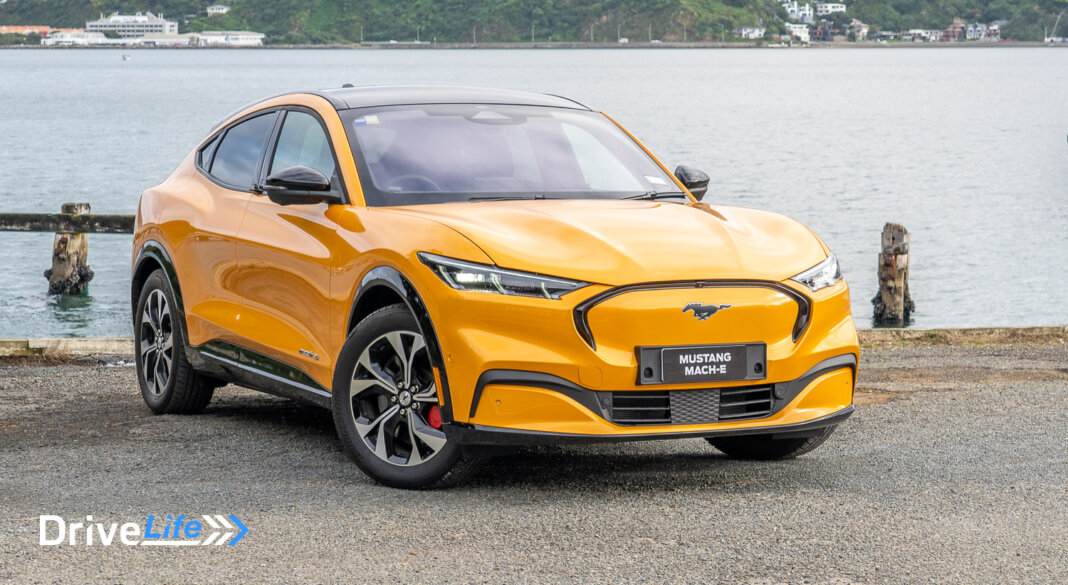There’s been a lot of angst both locally and internationally over the new Ford Mustang Mach-E. Most (if not all) of that angst, has been over the name, with many people wondering what on earth Ford was thinking to give an electric vehicle the iconic Mustang name.
At DriveLife, we review cars. We aren’t here to judge the Mexican-built Mach-E on its name – we’re here to give our unbiased opinion on this car, Ford’s first fully electric SUV. After heading to the launch in Auckland, we immediately drove the Mach-E 600km home to Wellington and then spent the next 3 weeks and almost 3,000km behind the wheel, with 2 drivers sharing the car.
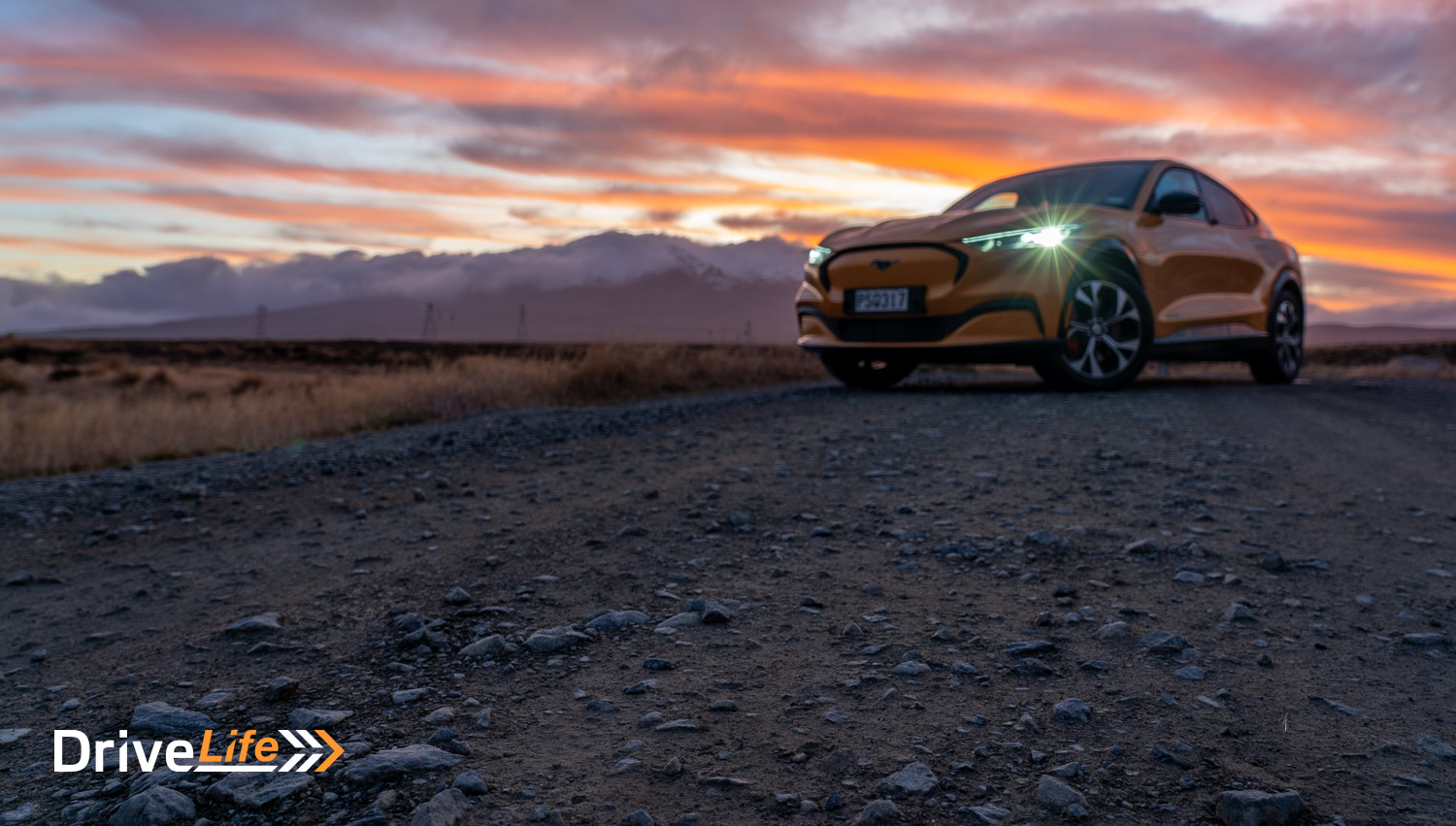
What We Like and Dislike About The 2023 Ford Mustang Mach-E AWD
| What we like | What we don’t like |
| Design Interior space Infotainment clarity and use Intelligent adaptive cruise control Intelligent speed limiter Driving dynamics Ease of day-to-day use Driving position Standard safety equipment Sheer ease of driving day-to-day | No tow rating No Vehicle-To-Load functionality No heads-up display Charge port location |
What’s In The 2023 Ford Mustang Mach-E Range?
New Zealand sees three models available:
- Rear-Wheel Drive (RWD) with a 75.7kWh battery (Standard Battery) at $79,990 (drive away pricing)
- All-Wheel Drive (AWD) with a 98.7kWh battery (Extended Battery) battery at $109,990 (tested)
- GT (AWD) with a 98.7kWh battery (Extended Battery) at $124,990
While the RWD model has a 75.7kWh battery pack for a WLTP range of 440km, the usable capacity is 68kWh. The AWD’s usable capacity is 88kWh and its WLTP range is 550km. With the same battery but more power, the GT has a range of 490km.
Power output for the RWD is 198kW and torque is listed at 430Nm. The RWD is 258kW and 580Nm, and the GT is a stunning 358kW and 860Nm of torque. The RWD will get to 100km/h in 6.1 seconds, the AWD in 5.1 seconds and the GT in 3.7 seconds.
Obviously, the RWD and GT are dual-electric motors to enable all-wheel drive capability. All models have a single-speed automatic transmission.
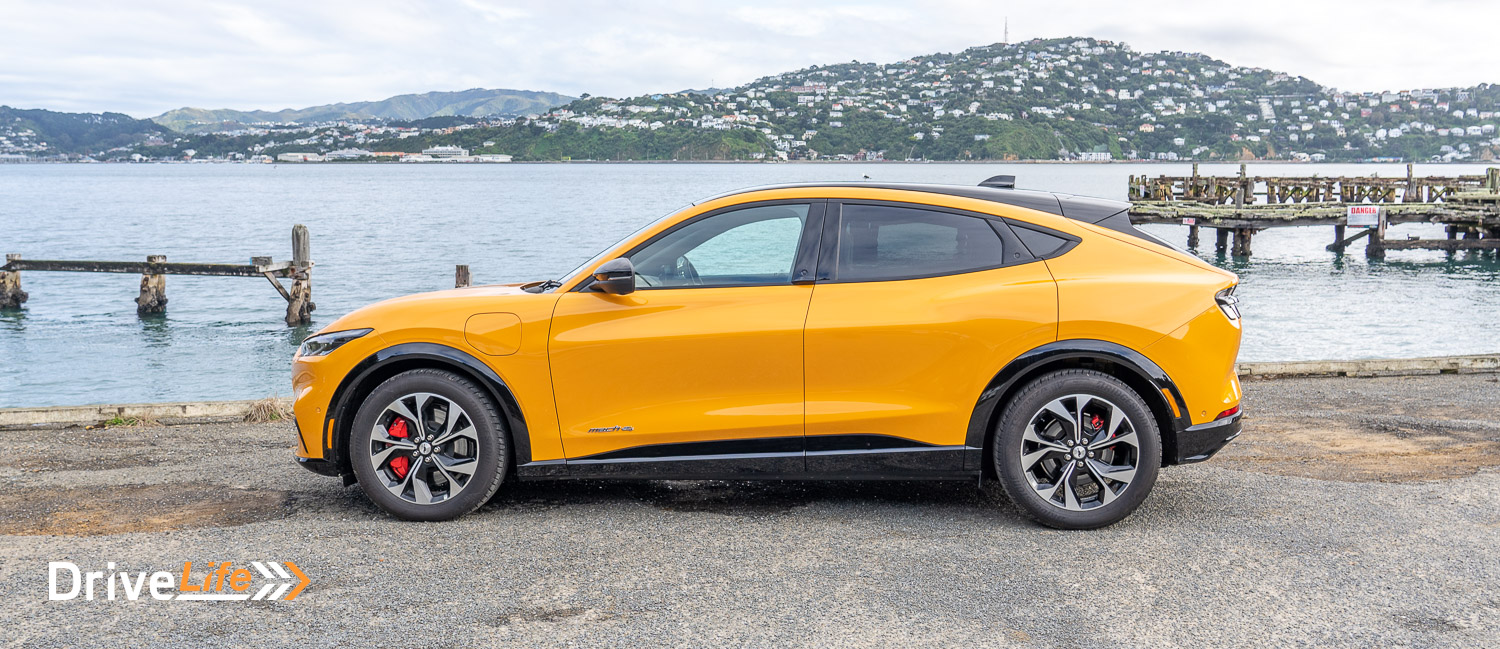
2023 Ford Mustang Mach-E Standard Equipment Highlights
- Automatic headlights
- LED DRLs
- LED taillamps
- Rear spoiler
- 18” alloys
- Tyre pressure monitoring
- Electric park brake
- Privacy Glass
- Automatic wipers
- Auto-dimming rearview mirror
- Heated steering wheel
- 6-speaker audio
- 15.5” centre colour touchscreen
- Apple CarPlay/Android Auto
- SatNav
- 10.4” LCD instrument cluster
- Wireless phone charging
- Keyless entry and start
- Alarm
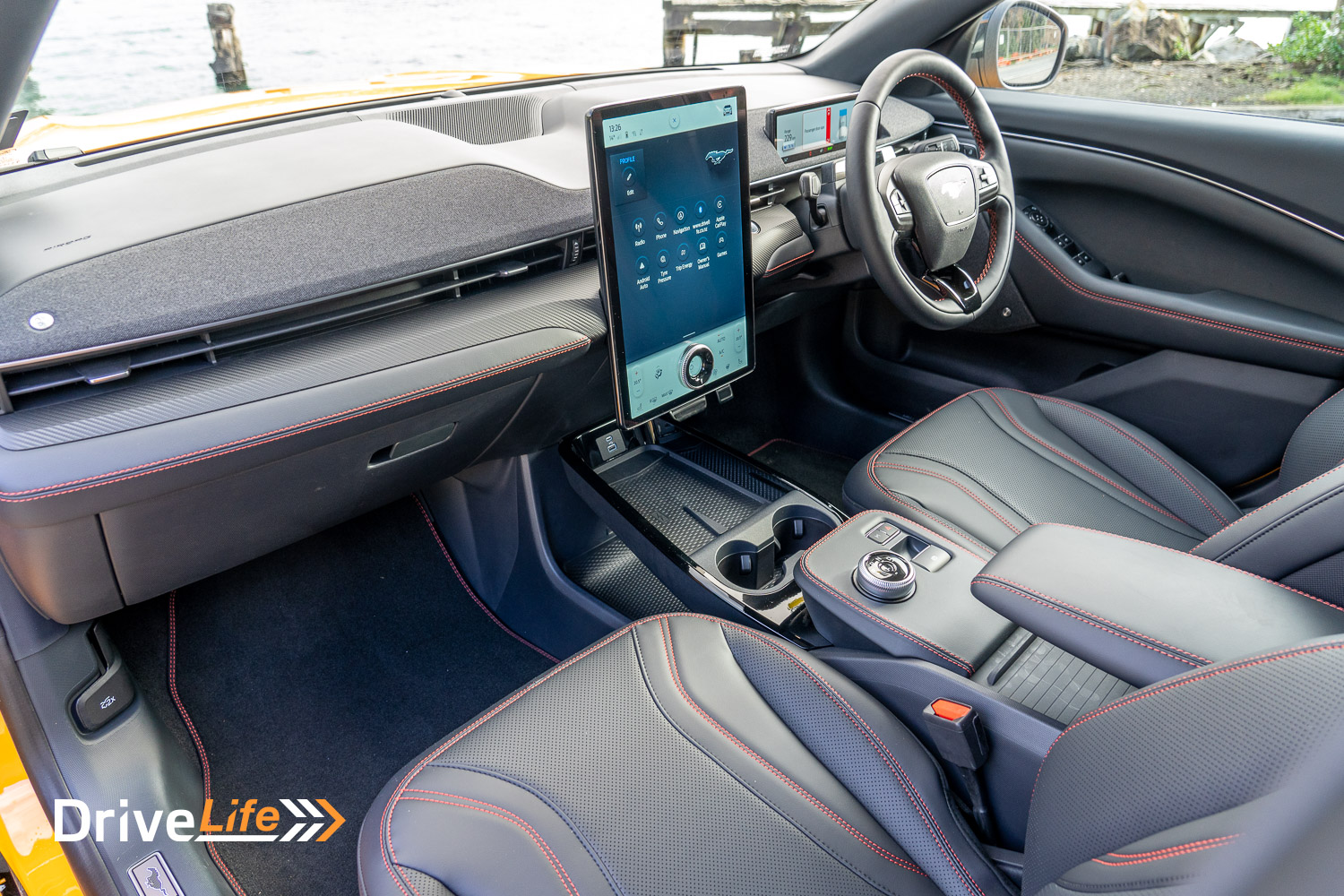
SAFETY EQUIPMENT
- Adaptive Cruise Control with Stop & Go technology
- Airbags – Driver and Front Passenger
- Airbags – Front Side & Front Curtain
- Airbags – Rear Seat Side & Rear Curtain
- Airbags – Driver Knee
- Anti-Lock Braking System (ABS)
- Autonomous Emergency Braking (AEB)
- Auto Hold Assist
- Beltminder – Driver and Front Passenger
- Beltminder – Rear Passengers
- Blind Spot Information System w/ Cross Traffic Alert
- Dynamic Brake Support (DBS)
- Emergency Brake Light
- Electronic Brake Boost
- Evasive Steer Assist
- Driver Impairment Monitor
- Electronic Stability Control
- Forward Collision Warning
- Intelligent Speed Assist with speed-limiting device
- Intersection Assist
- Traffic Sign Recognition
- Parking Sensors – Front
- Parking Sensors – Rear
- Post Impact Braking
- E-latch door handle
- Reverse Brake Assist
- Front Camera
- Rear View Camera – 360
Moving to the Mustang Mach-E AWD model adds:
- “Glare Free” automatic headlamps
- LED Projection Headlamps
- Electric tailgate
- 19” alloy wheels
- 8-way power driver and front passenger’s seats with electric lumbar adjust with memories
- Perforated Sensico seats with red stitching
- LED Ambient lighting
- Panoramic fixed roof
- 10-speaker audio system
Moving to the Mustang Mach-E GT model adds:
- Suede-like performance seats
- Sports steering wheel
- For a full list of specs and options available for the 2023 Ford Mustang Mach-E head on over to the Ford New Zealand website.
How Does The 2023 Ford Mustang Mach-E AWD Compare To Its Competition?
All prices below exclude the refund or additional cost of the New Zealand Clean Car Programme.
| Make/ Model | Battery Capacity kW-hr | Power/ Torque kW/Nm | 0-100km/h seconds | Range (WLTP) | Boot Space, litres | Price (excl CCP) |
| Kia EV6 GT Line | 77.4 | 225/605 | 5.2 | 484 | 490 | $111,990 |
| Ford Mustang Mach-E AWD | 98 | 198/430 | 5.1 | 550 | 519 | $109,990 |
| Hyundai Ioniq 5 Limited (solar roof) | 77.6 | 225/605 | 5.1 | 430 | 537 | $109,900 |
| Polestar 2 Long Range Dual Motor | 78 | 300/660 | 4.7 | 480 | 405 | $104,990 |
| Tesla Model Y Performance | 81 | 336/639 | 3.7 | 514 | 854 | $101,400 |
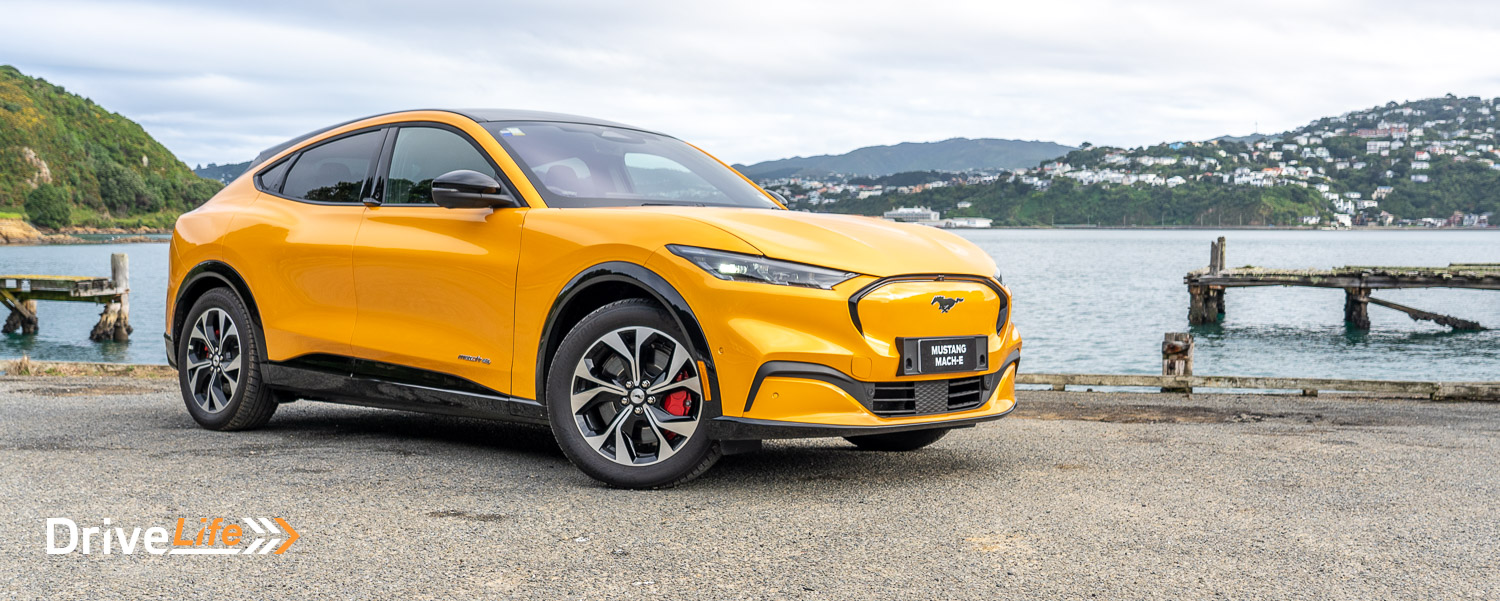
First Impressions Of The 2023 Ford Mustang Mach-E AWD
Regardless of its name, the Mustang Mach-E – especially finished in Cyber Orange – looks great. But, that’s just my view; others gagged a little, possibly that is still related to hang-ups on Ford calling it a Mustang.
For me, the buyers of the Mustang Mach-E are those who would not buy, for example, the Hyundai Ioniq 5 or Ioniq 6 – because they’re just too out there in their design. While we at Drivelife like the design of those cars, other buyers want something a bit more contemporary and simple. The Mustang Mach-E is both of those things, and manages to pull across design features from the petrol-powered Mustang. One of those design cues is bonnet bulges. Again, maybe just for me, these were a step too far. There is no V8 under the hood, so please, no bonnet bulges. That’s not to say they don’t look good – especially from the driver’s seat, but these are things that are really out of place on an EV.
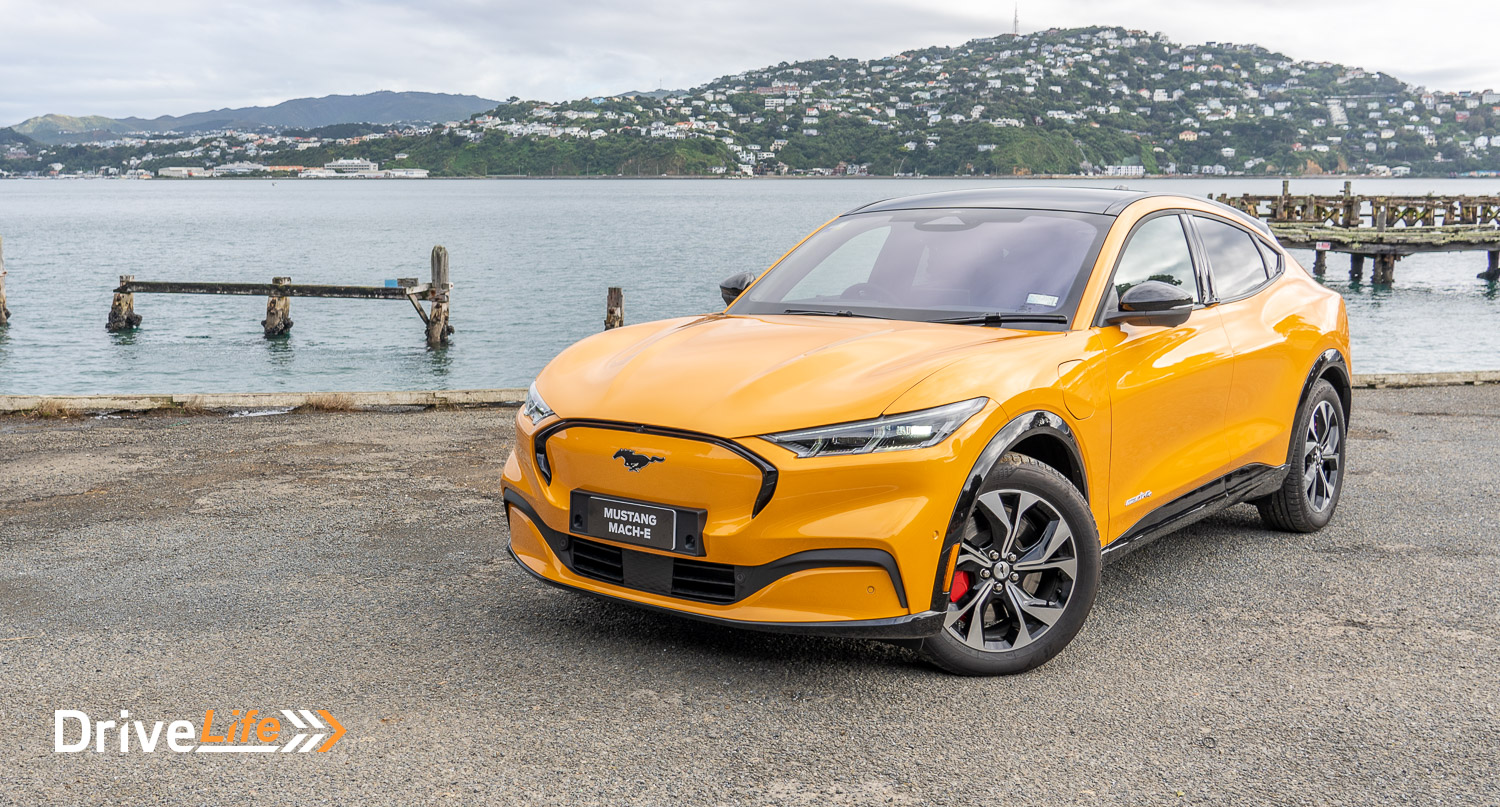
So while our Cyber Orange colour Mach-E looked great to me, that isn’t a colour that’s normally on the AWD model, but our test car was an Irish-spec – in New Zealand, only the GT model will be available in this colour. Sequential indicators front and rear set the car off when in motion, and another modern touch is electronic door buttons, giving the car a nicely streamlined look side-on.
The Mach-E was probably the most commented-on test car I’ve had so far this year. More than once in my local supermarket car park, I would hear some kid yell out, “Look, Dad, it’s the new Mustang!”. That’s the power of television advertising for you. I also went through a breath-testing checkpoint, and the young policewoman who came to the driver’s window first said, “Oh, is this the new Mustang?”. So while many are gnashing their teeth over the name and the fact that it’s an SUV and a Mustang, there are others that love it.
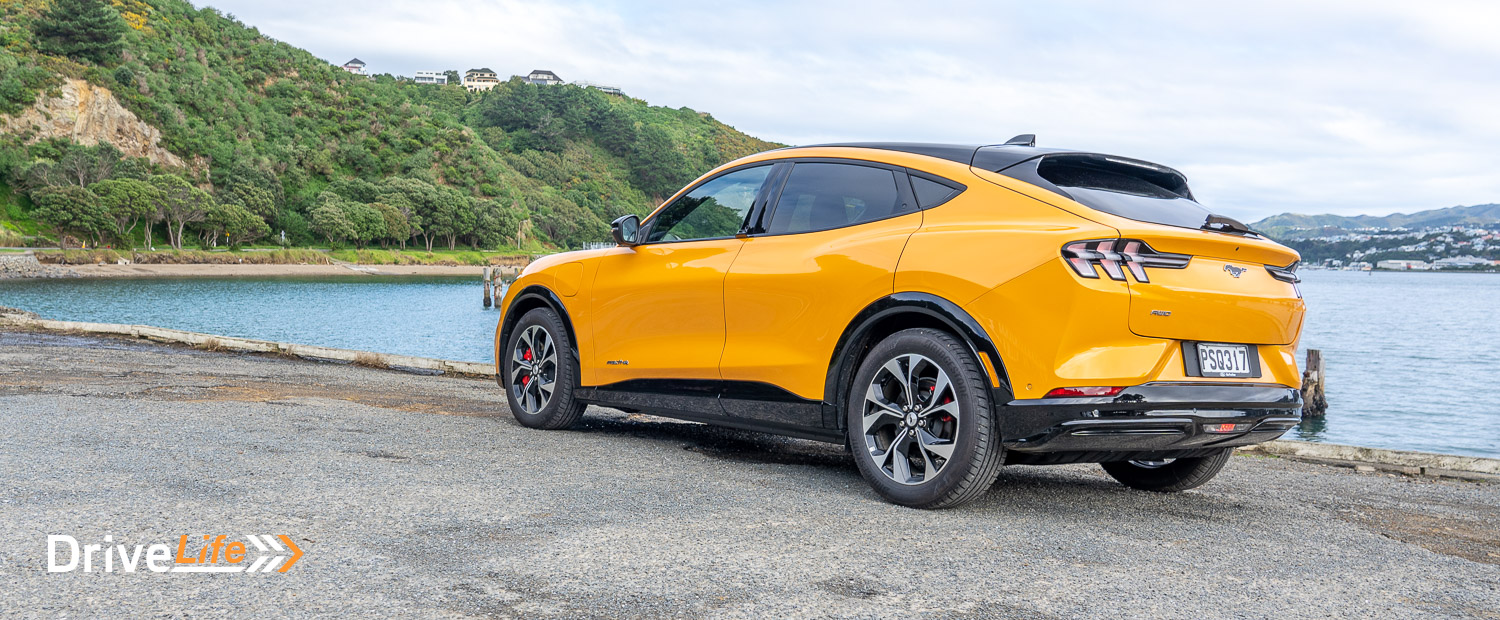
What’s The Interior Like In The 2023 Ford Mustang Mach-E AWD?
Since the Mach-E is built on an EV-only chassis, that means gallons of room inside, and a flat floor, front and rear. So nice to see there is no transmission hump in the rear, like we saw in the Polestar 2.
The doors all open wide to make for an easy entrance, but you can certainly see the battery pack in the sill. The sill is enormous and while this doesn’t make getting into car that much more difficult, it’s an in-your-face reminder that this is an EV.
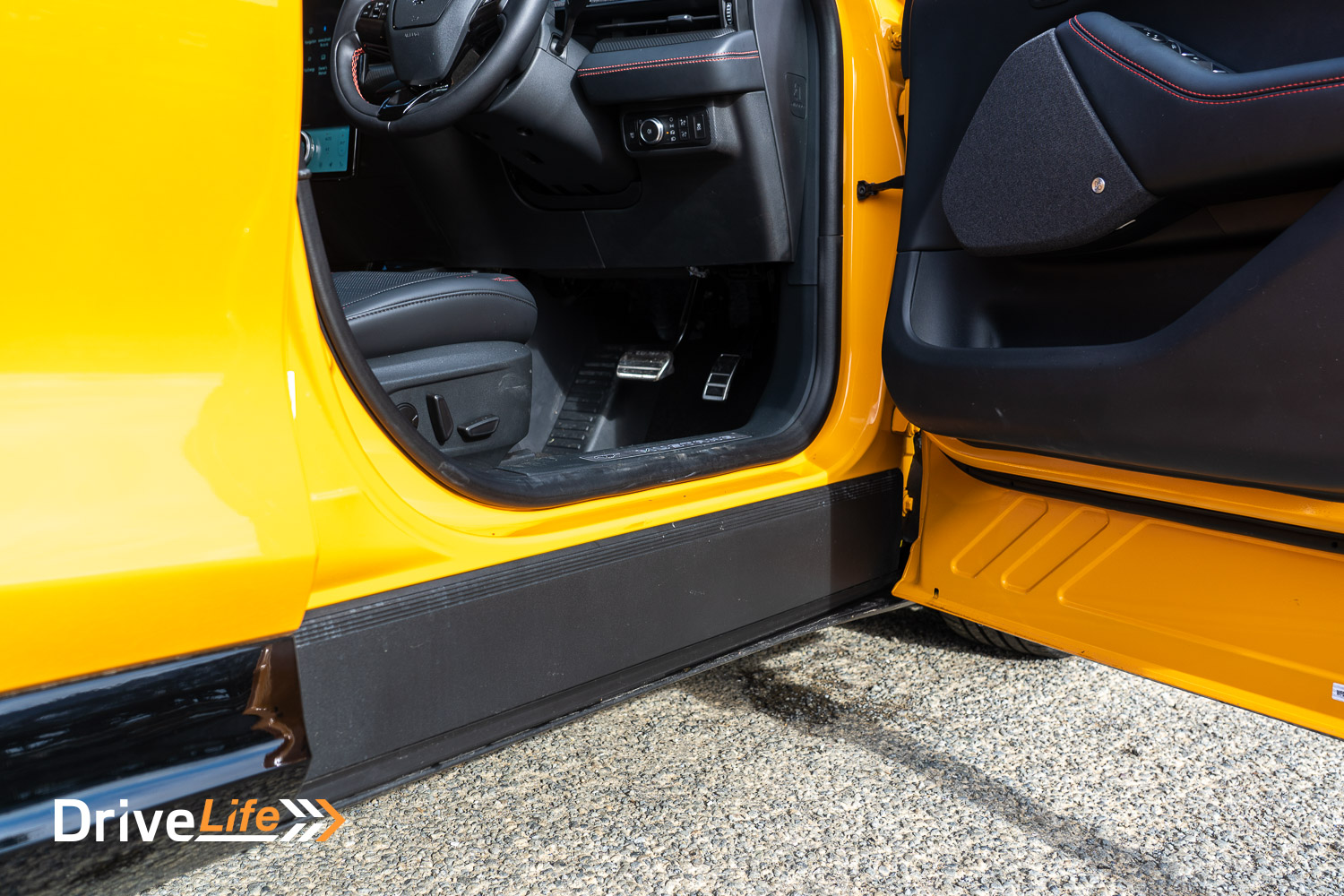
The interior itself is pretty much all normal Ford stuff; the same controls, and the same huge centre screen that we saw in the Ranger and Everest. There is lots of shoulder, leg and headroom for all, and the (fixed) panoramic sunroof lets in a load of natural light. Like the Model Y, there’s no blind or electronic dimming of the roof. Since our test was in winter, I can’t comment on if it would make it too hot inside on a sunny day. I barely saw any sunny days for our entire test period of 3 weeks.
Since we spent so much time and so many kilometres in our test car, we really got to grips with the good and bad points of the interior. One not-so-good issue is the bottle holder in the doors. It’s too small, and will only take perhaps a 500ml plastic bottle of water. My larger-sized water bottle kept getting stuck in the holder, so I had to move it to the centre cup holders. Not the end of the world, but I prefer to keep the middle of the car clear if I can. The front doors do have a normal storage area, and on the rear of the door panel there’s a sort of hidden compartment that could take a few wallets and other small things to get them out of sight. Beware though, if you have hands that are, well, “chunky”, you might struggle to get back what you put in. The entry hole is tiny.
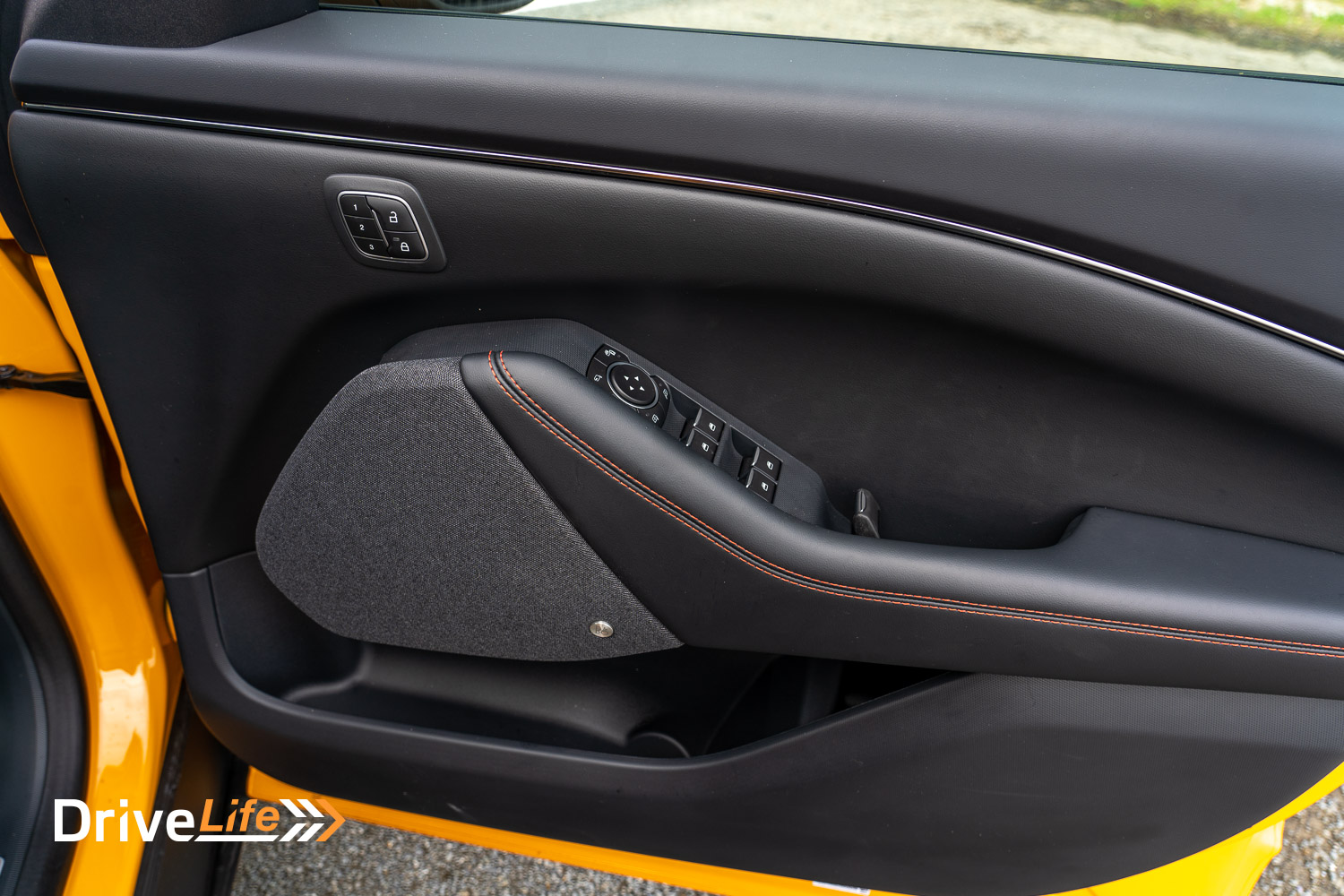
The rear doors don’t have any water bottle holders at all. There is space for them, but the design of the door panel stops this. There are cup/bottles holders in the fold-down centre armrest.
I realise I’m still going on about doors, but bear with me. The finish on them is excellent, with soft-touch materials all over, except on the lower third. They feel and look classy, but still retain some form of being an SUV by having the lower part in hard plastic – easy cleaning!
As mentioned, from the outside the doors are opened electronically with a button. Above the front-door buttons are some number buttons; you can program these to be able to open the door without the key. You can’t start the car without the key, but it does mean if you forget your key you can still jump in the car and grab something.
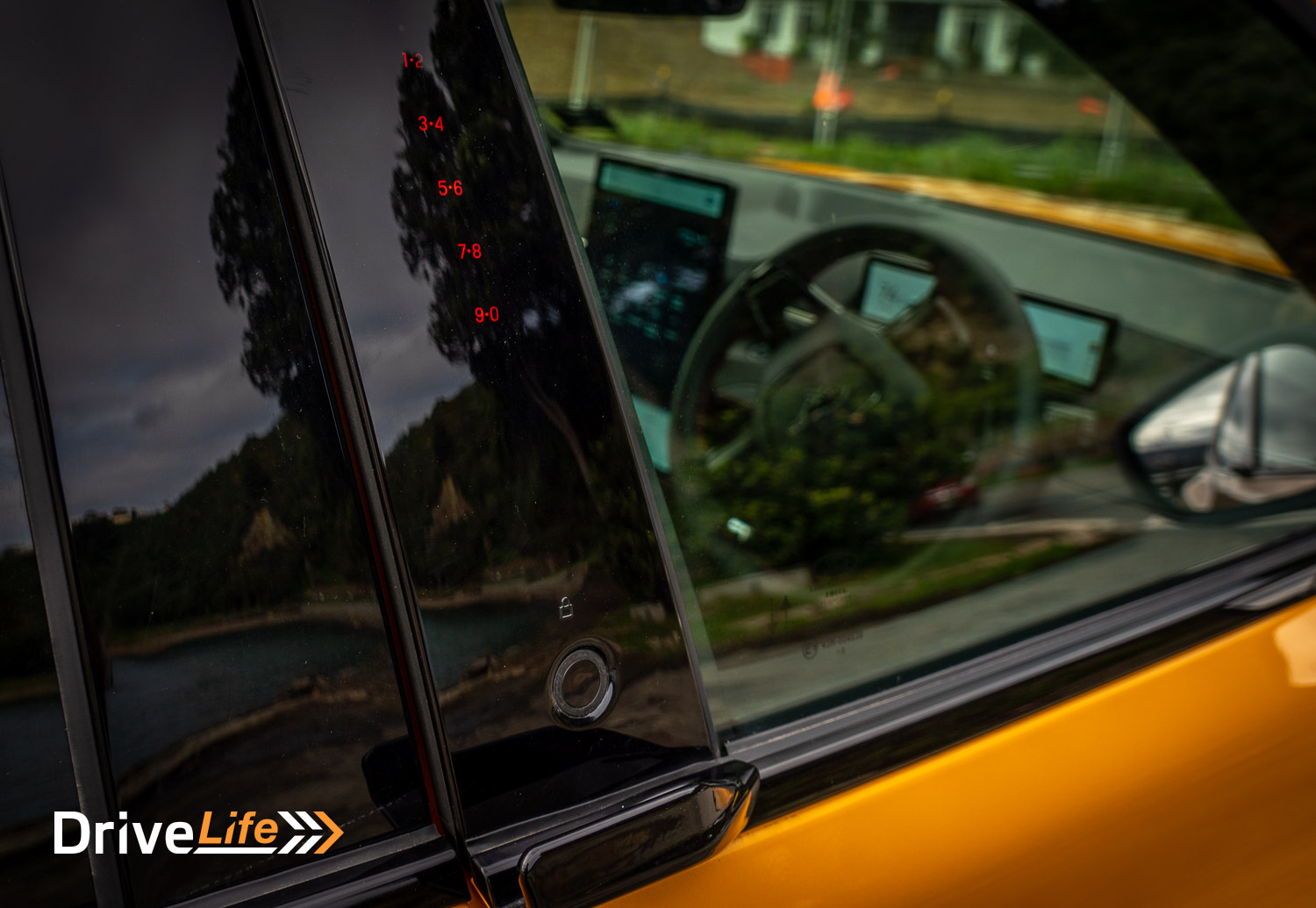
While the front doors have some small door pulls on the outside, the rear doors pop open when you push the button. At this stage when the rear door is open, it can’t go straight back to closed, so no danger of children getting their fingers jammed.
The interior of our test car was finished in black, and the car really needed that panoramic sunroof to make it a little lighter in there. The rear door windows are quite small, so as much natural light as you can get in is needed. During the launch, we sampled a car with a light interior, and it was far better for making the car feel brighter inside.
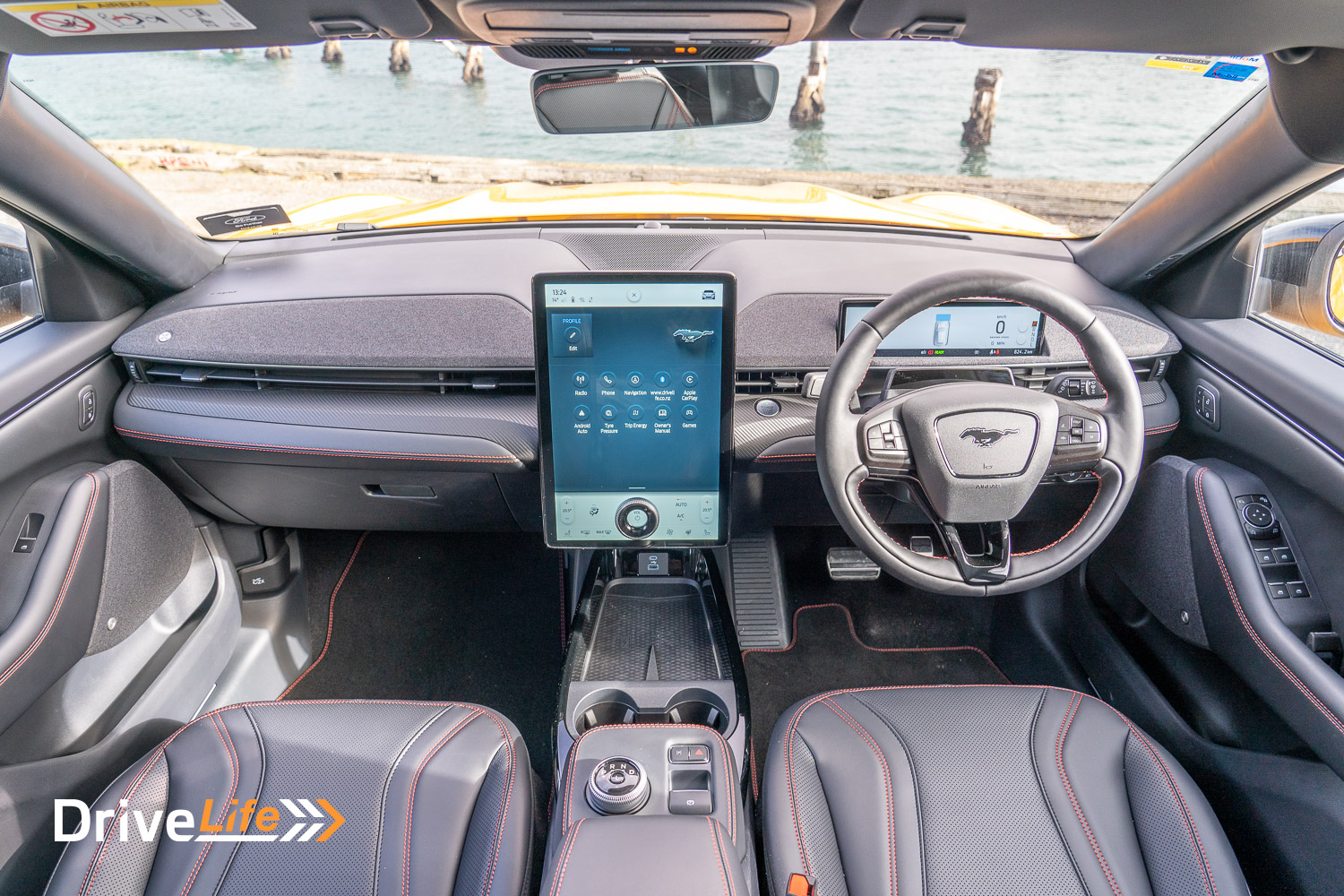
All through the cabin, there was red contrasting stitching on our test car; across the seats, centre console, steering wheel and dash. I love red stitching with a black interior – very sporty. That centre console is a double-height unit, with plenty of storage. While the floor in the Mach-E is flat, the console goes right up to the dash.
At the front of the console is what looks like a double Qi wireless-phone charger, like the Tesla Model Y and Model 3 have. But only one side (the left side, a hangover from LHD?) is actually a wireless charger. I wonder how much extra it would have cost to make both pads wireless chargers.
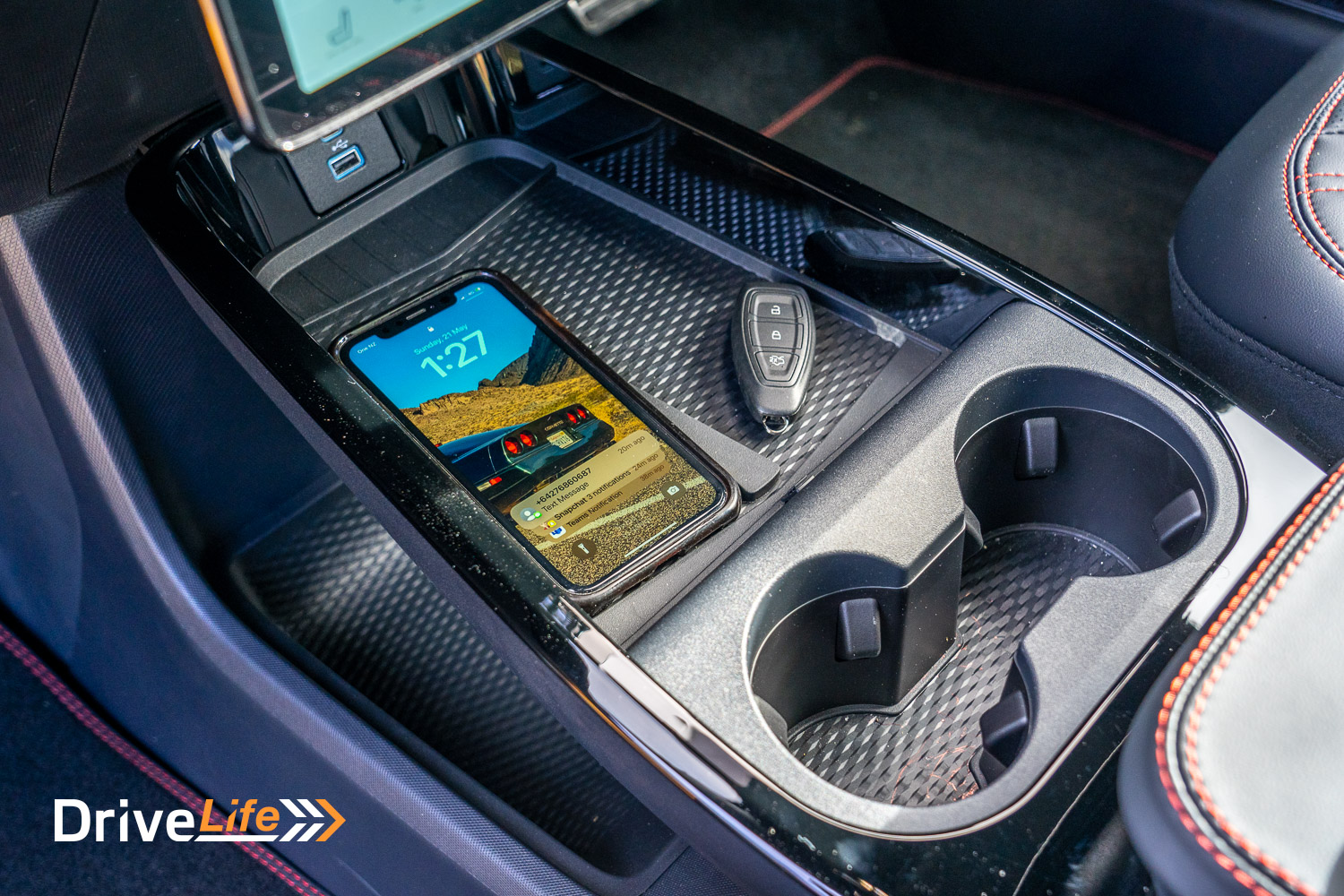
Further back is a rotary transmission dial, like we have seen in the Focus. It might make some people apprehensive, but it’s pretty simple to use – just turn it left or right. There is no end stop, so (for example) from Park you can just spin the rotary dial around to the right as many clicks as you can be bothered with, you’ll know it’s in Drive. Well, at least 3 clicks, anyway. You need to dial past Reverse and Neutral to get to Drive. I know Alistair didn’t like this at all (no end stops) but it didn’t bother me in the slightest.
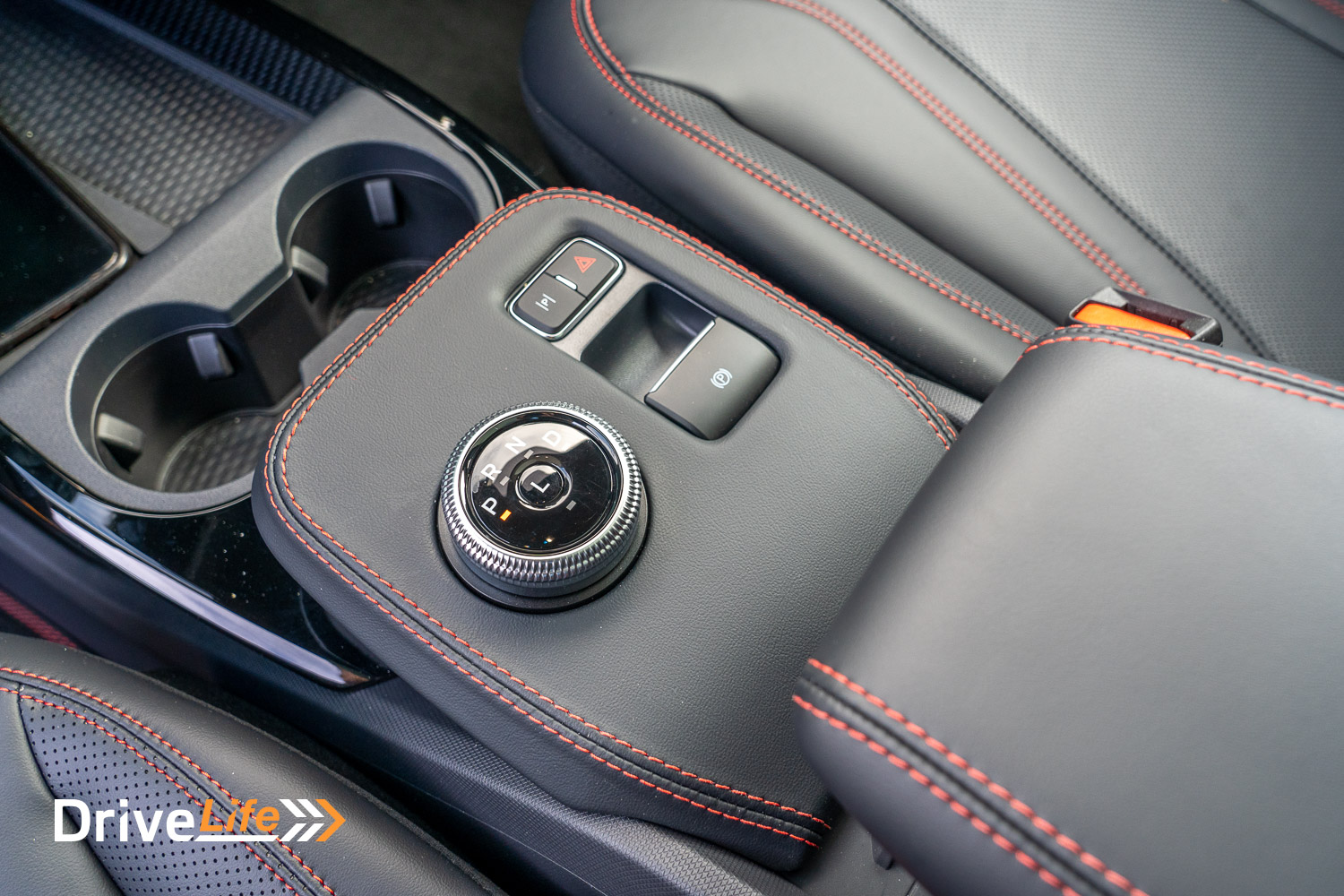
There is a 12-volt socket in the centre cubby, but that’s the only one in the front. Front-seat passengers get access to a single USB-A and USB-C ports, and it’s the same for rear passengers. The dash on the AWD model has a nice cloth finish to it, with the tweeters hidden under the fabric. Under that part of the console is a full-width piece of fake carbon fibre that thankfully doesn’t look too out of place, or overdone.
The AWD model has 7 choices for ambient lighting, and the interior is a nice place to be on a night drive. That huge centre screen does dominate, but it’s pleasant enough to be able to spend many hours in darkness on the road.
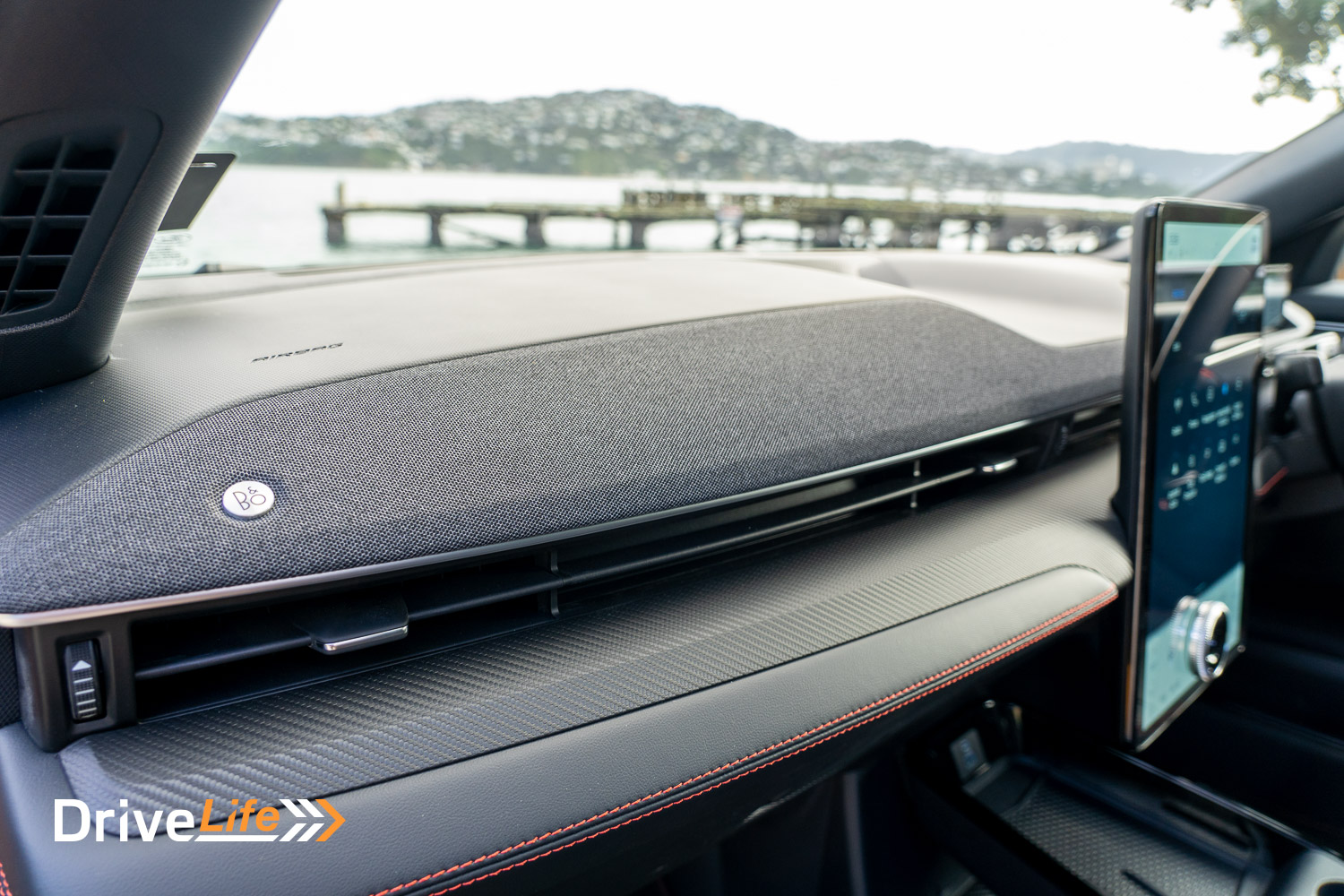
Around the back of the car, there’s a relatively high load height into the boot. Storage space is listed at 519 litres with the rear seats up, and under the floor is the bag containing a tether cable for charging at stations where you need one (rarely), and a tyre pump. There is no spare tyre for the Mach-E. The false floor does offer some extra but slim storage space, and the boot itself has a 12-volt socket and two hooks for bags.
The Mach-E does not offer any sort of Vehicle-To-Load (V2L) capability, so you can’t plug any appliances etc into the car and run them off the drive battery.
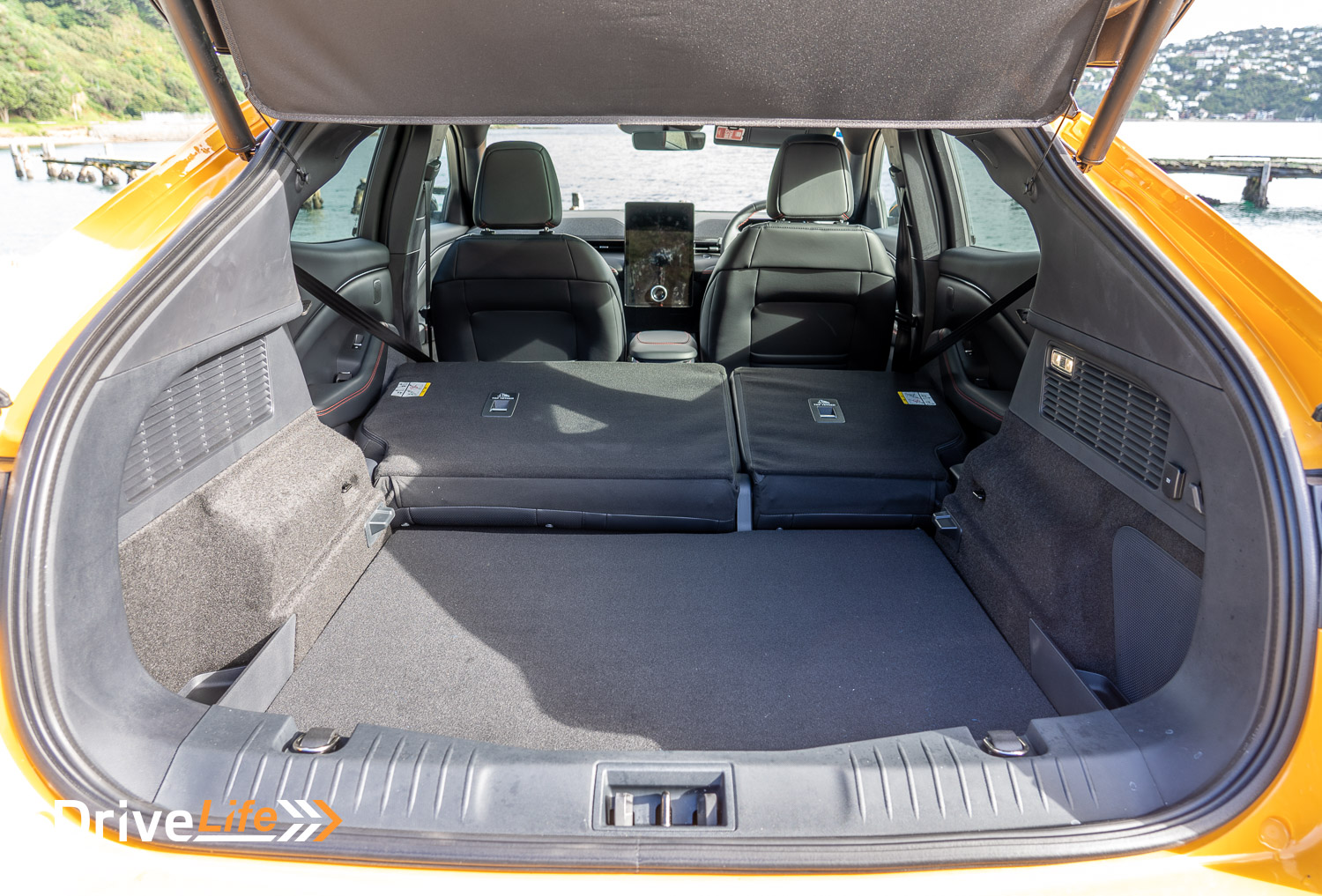
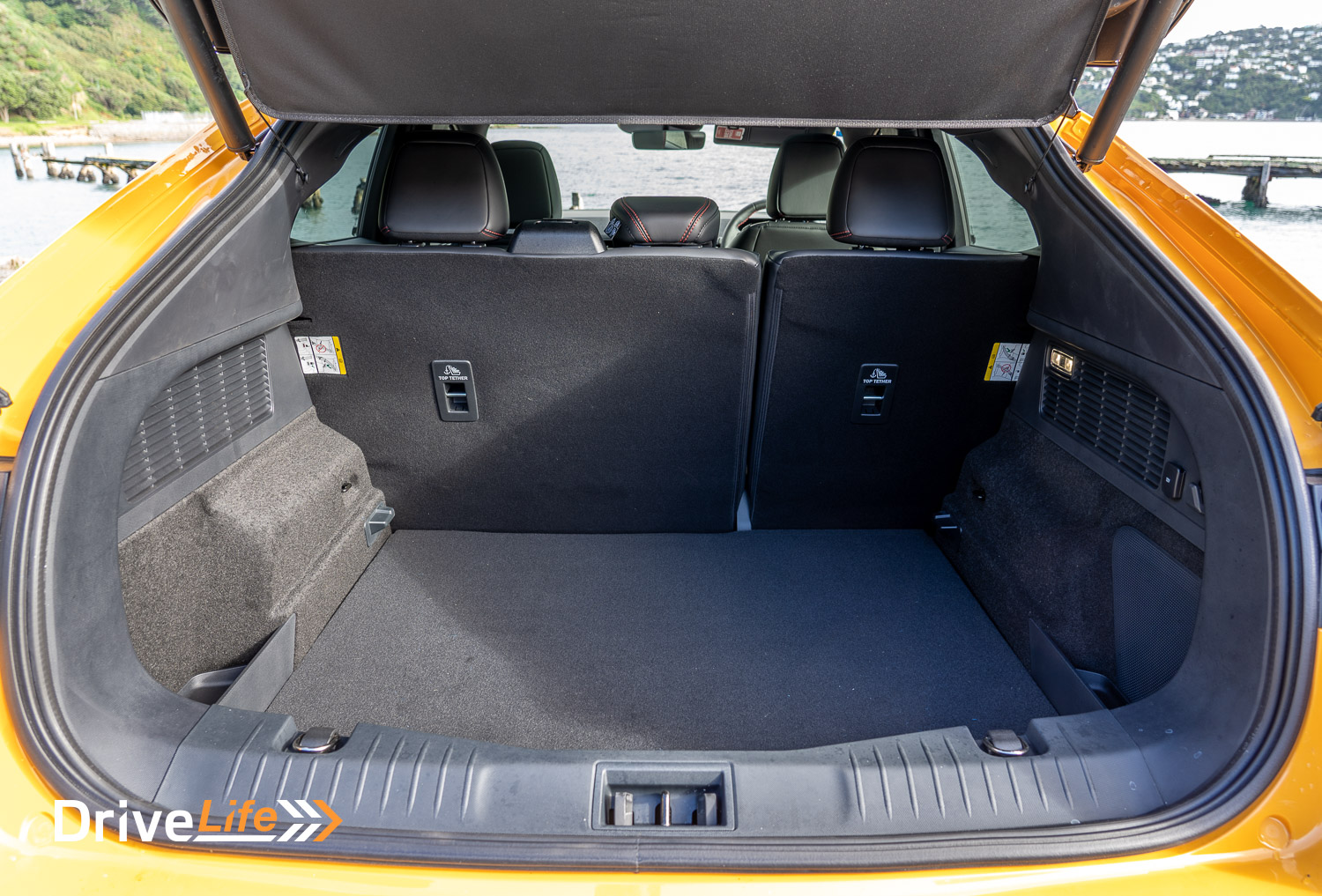
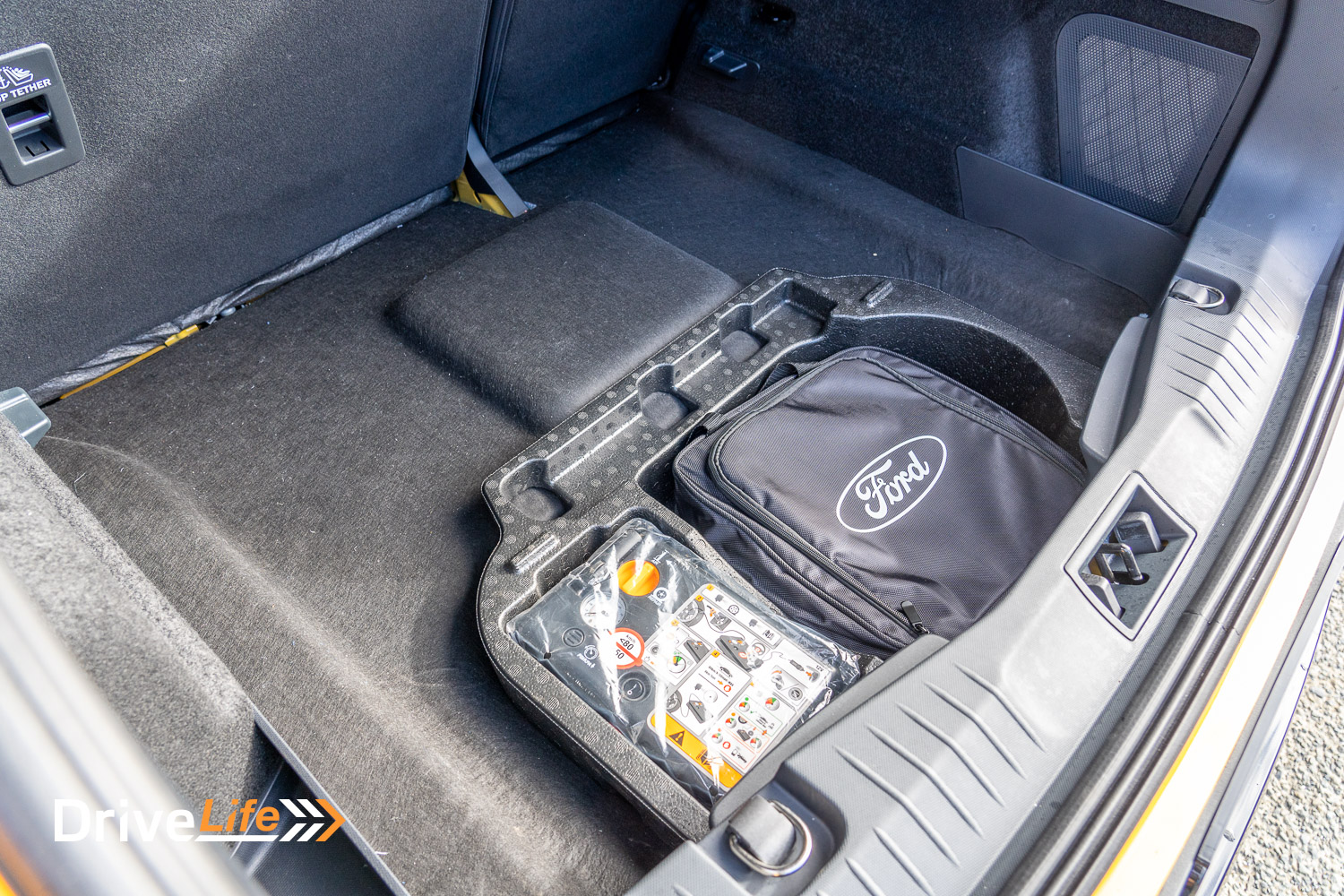
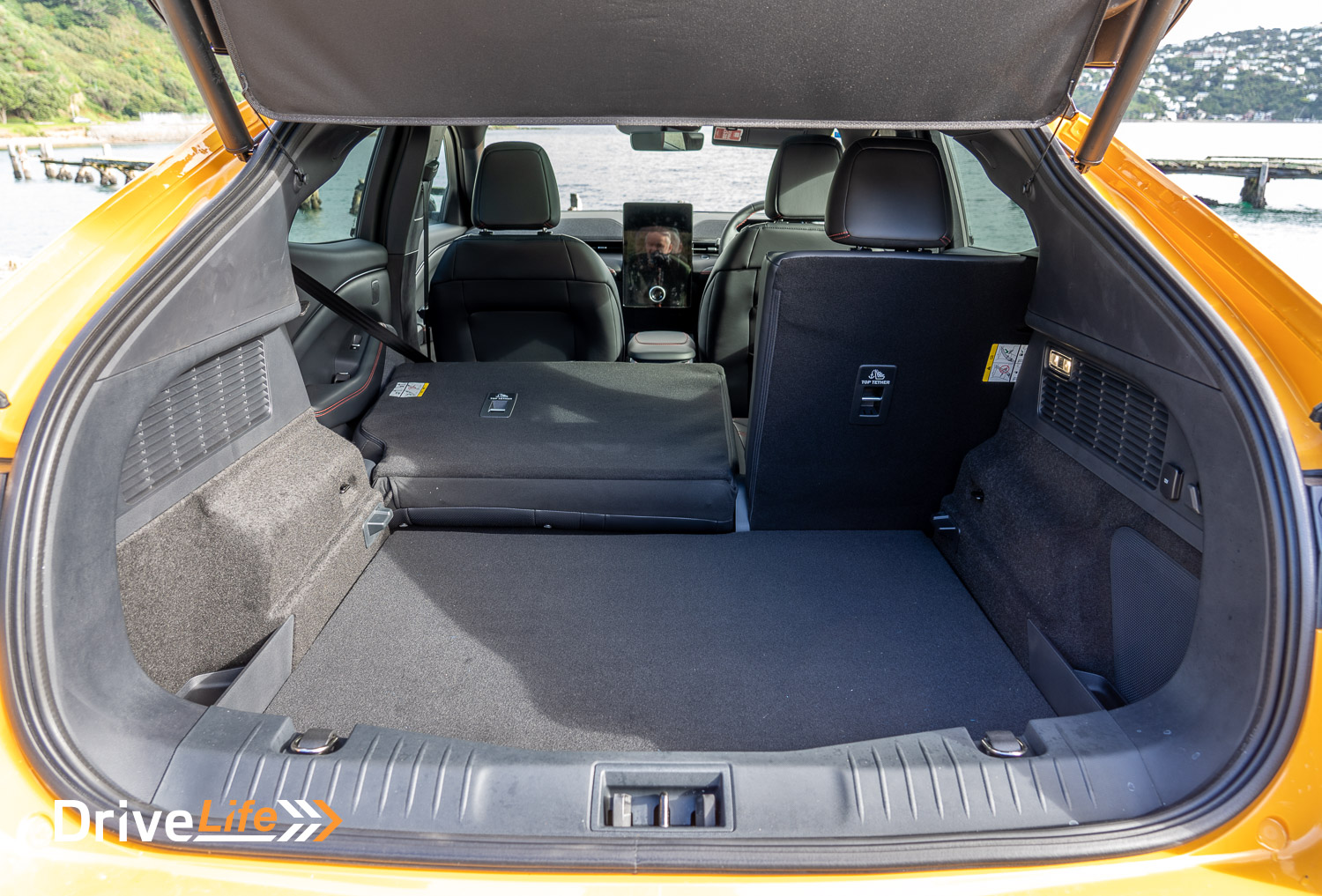
What’s The 2023 Ford Mustang Mach-E AWD Like To Drive?
After driving the Mach-E 600km from Auckland to Wellington, it was time to do some commuting.
First off, a small complaint. Ford has given us this modern, fresh and newly designed EV, and has also given us the most boring key in the world. It says Ford on one side, and has buttons for the boot, lock and unlock on the other. It looks like a key from a Fiesta (it probably is). It’s a small point, but the key is a disappointment.
On that daily drive, visibility is mostly good. The small rear windows don’t help there, but blind-spot monitoring should keep you safe at least. The A-pillars are fairly chunky, as are the B pillars. This is one of those cars where you need to move your head some to see around the pillars when backing out of a driveway.
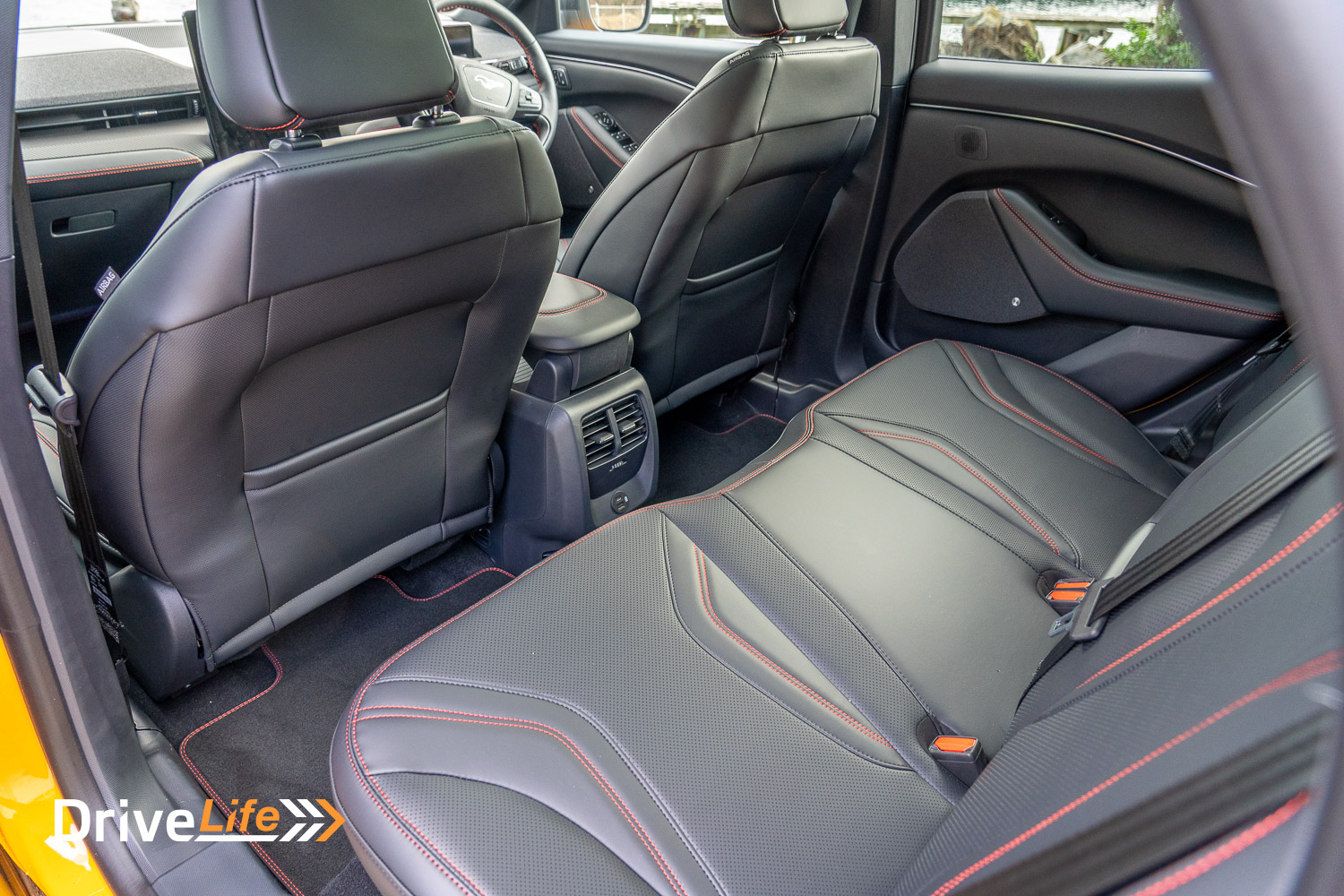
Over so many kilometres of testing, the driving position on the Mach-E was perfect. Ford has really nailed the steering wheel/seat/pedals setup, for me at least. There’s plenty of adjustment in the driver’s seat, and it goes a long way back for those tall, lanky American drivers. The driver’s seat goes a very long way forward too, giving the passenger in the rear a mind-blowing amount of legroom. Another bonus is the driver’s sun visor; it covers around 95% of the door, so you can block out nearly all the sun that’s streaming in on your vision. After a string of cars with terrible sun visors, these ones are near-on perfect.
Still in the driver’s seat, the steering wheel feels excellent. It’s pretty chunky, and that’s how I like them. The controls on the wheel are standard Ford, so that means simple and easy to use. Cruise control and speed limiter on the left, and audio/phone on the right means it doesn’t take long for your brain to know exactly where to go.
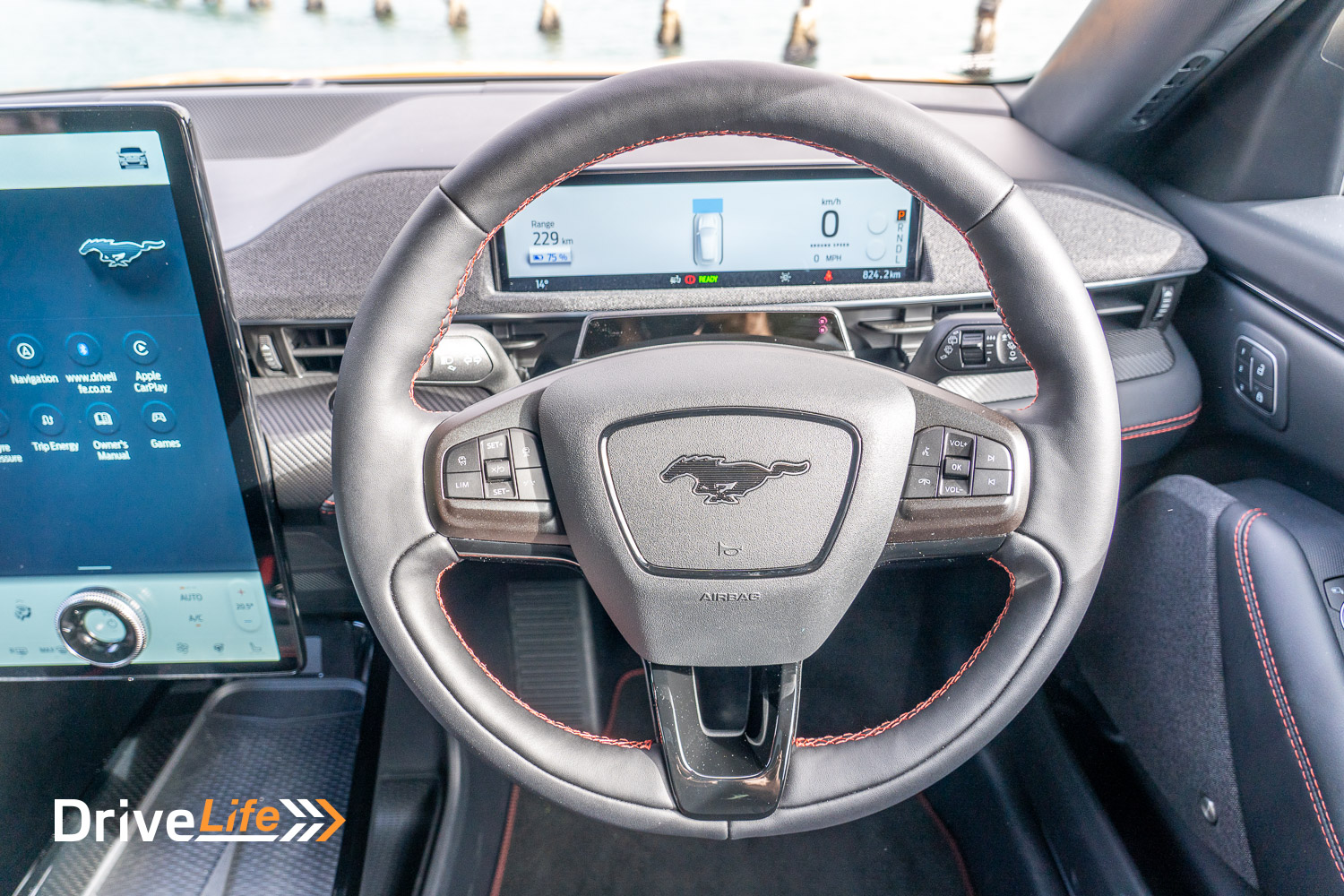
The Mach-E has no variable regenerative braking, so there are no paddles on the steering wheel. Your options for regenerative braking (regen) are One Pedal, or off. That’s it. I’m guessing Ford has tried to make it simple, although having some adjustments on the move would have been nice. To turn One Pedal driving on or off, you have to touch the settings button on the centre screen, which brings up the drive modes and also options around One Pedal driving, Propulsion Sound, and an ambient light setting which links it to the drive mode. One Pedal driving is the mode I used most of the time; as you lift your foot off the accelerator, the car will start slowing with regen. It does mean you almost never need to touch the brake pedal. One Pedal driving isn’t ideal on the motorway or open road, so I turned it off for those times. That’s when it would have been nice to have the controls for this more easily accessible.
You get to choose from 3 drive modes; Whisper, Active, or Untamed. A nice touch that we rarely see is that the car will remember the drive mode after you turn it off. This means if you select Whisper mode, it won’t change until you physically change it on the screen – it’s unusual to see this in a car. And actually, using Whisper (consider it eco) mode is so easy, I did leave it on most of the time. If you want to show off to your mates, switching the car to Untamed will give you the most performance available, getting the Mach-E to 100km/h in 5.1 seconds. The car is affected by weight, so if you go 5-up you will definitely notice it’s not as punchy off the mark.
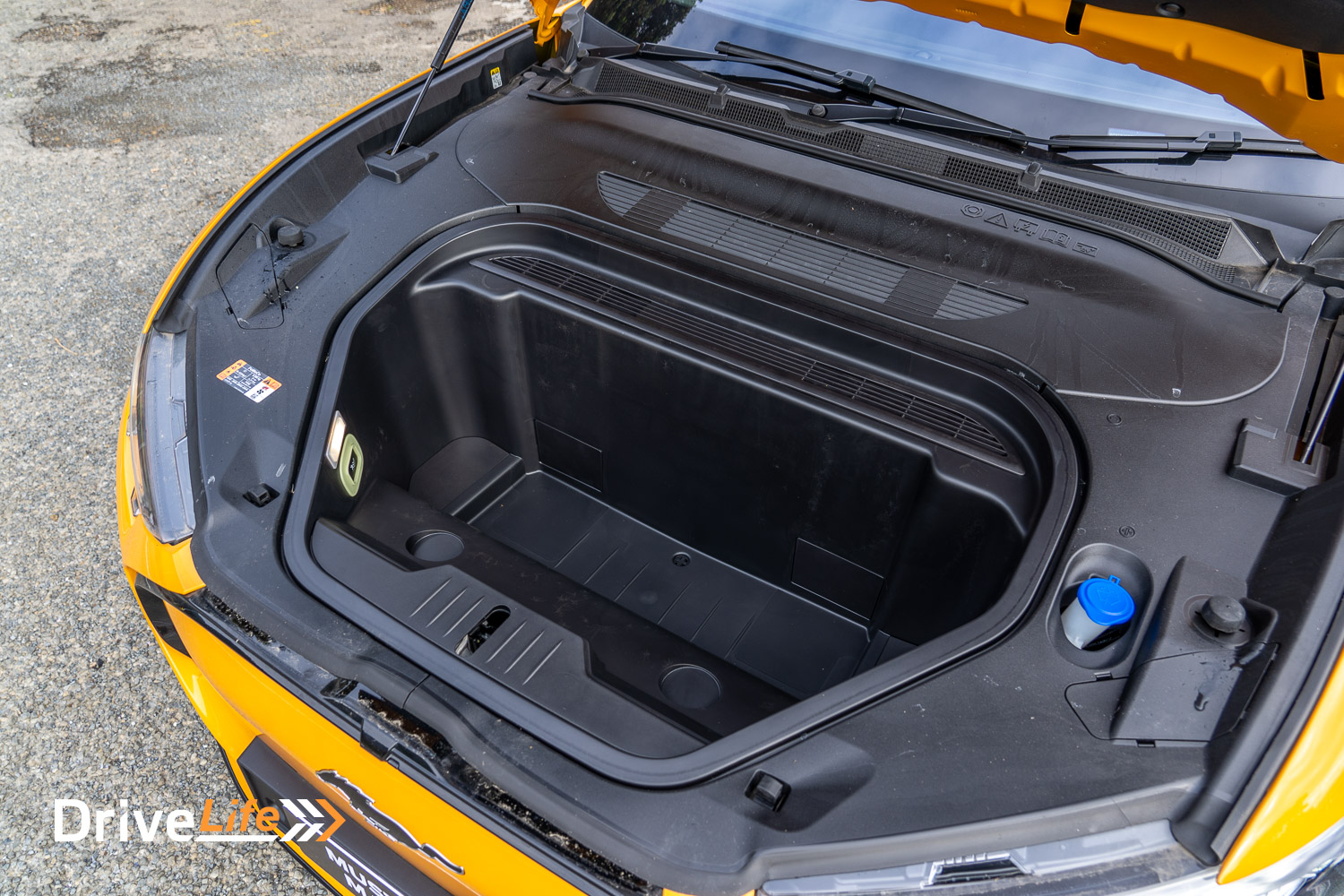
On the drive modes screen, you can also turn on Propulsion Sound. It’s not as bad as it sounds, and increases in volume depending on which mode you are in – of course, Untamed gives you the highest volume. Switching into Untamed mode will also see the ambient lighting turn red, but this is an option you can turn off.
That centre screen is certainly dominating, almost to the point of perhaps just too big. I would have loved to have had physical AC controls instead of screen buttons; it was often difficult to adjust (for example) the heated seat settings while on the move. All New Zealand models of the Mach-E will have the physical dial in the centre of the screen linked to whatever you are doing, so that means when you adjust the heated seats or AC you can use the dial to turn it up or down. That’s a far better idea, although making all these controls physical would have been better.
The user interface is quick at least, and the definition is excellent. It takes very little time to get the hang of the menus and screens. I’m guessing to keep things simple, Ford has opted to not have any fancy EV screens. There’s little EV info to be found on the centre screen, other than your normal trip meters which give a kWh/100km energy economy figure.
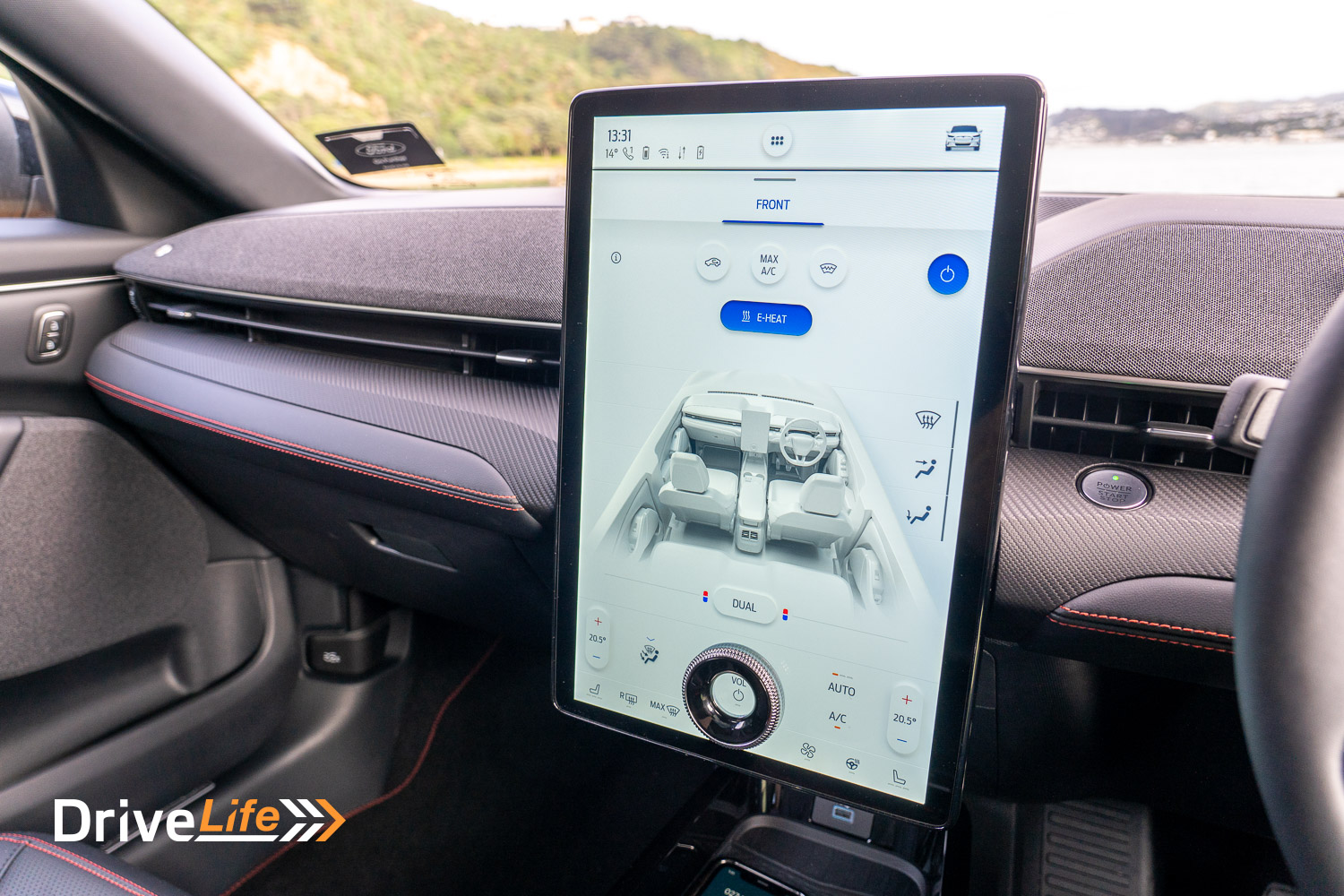
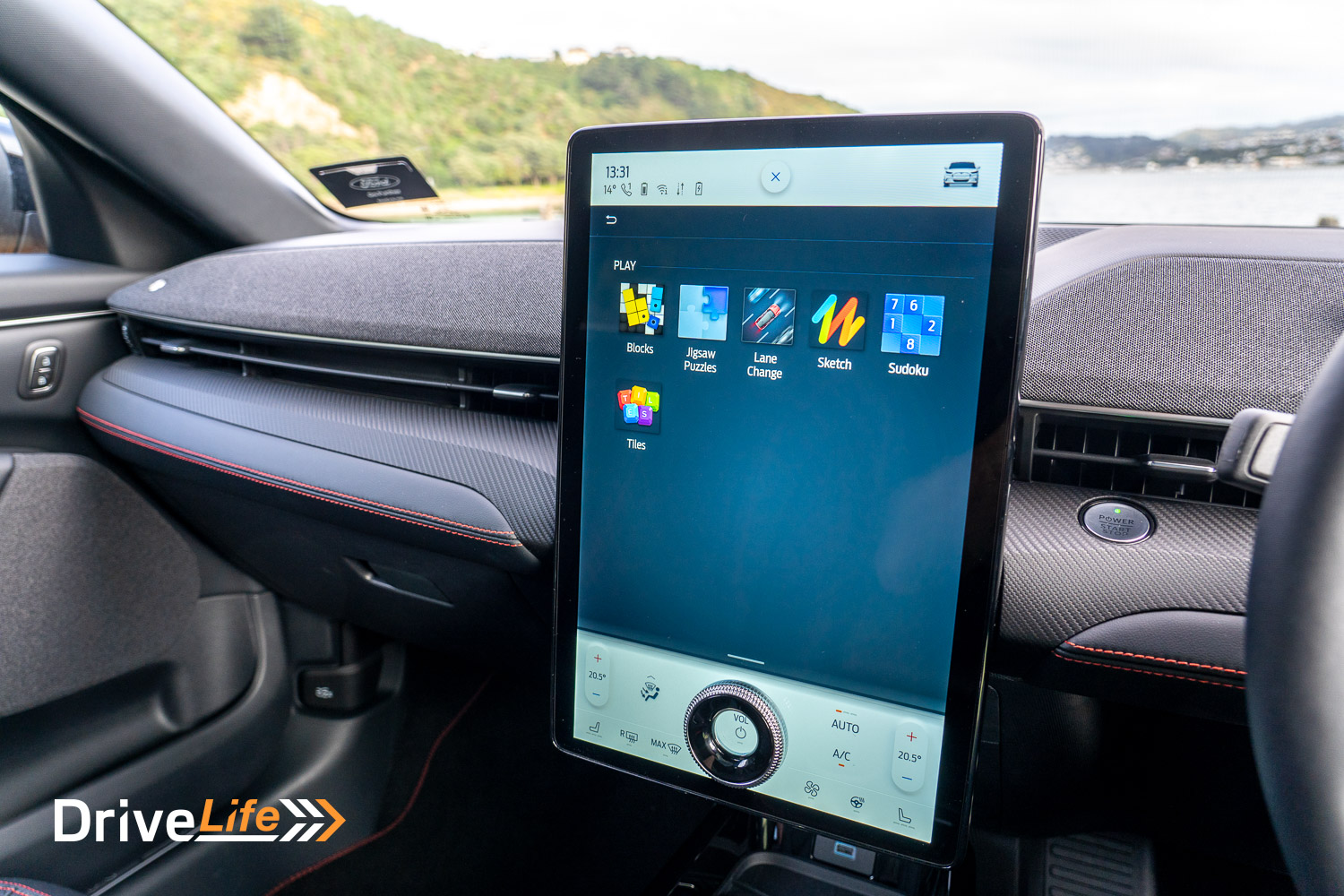
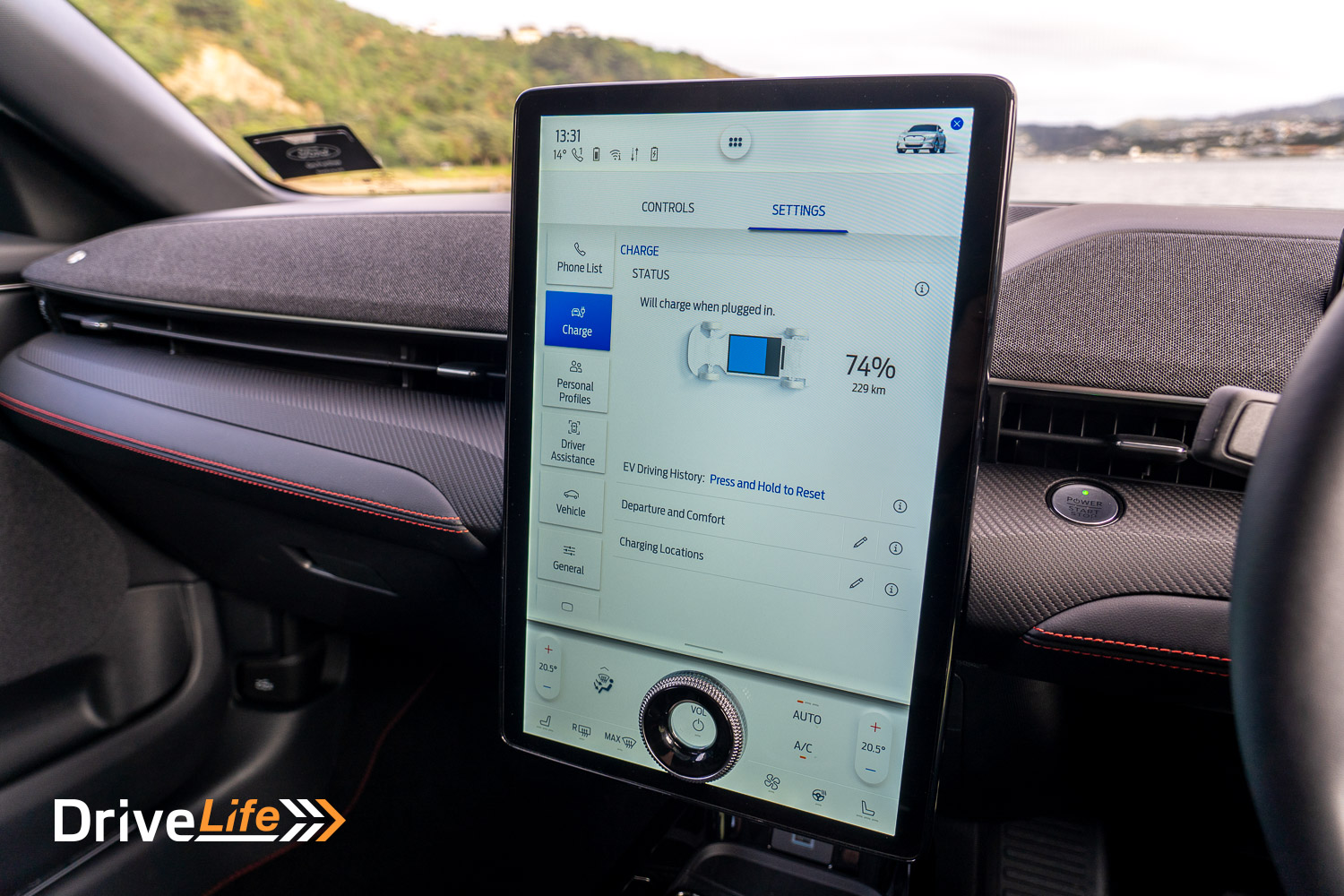
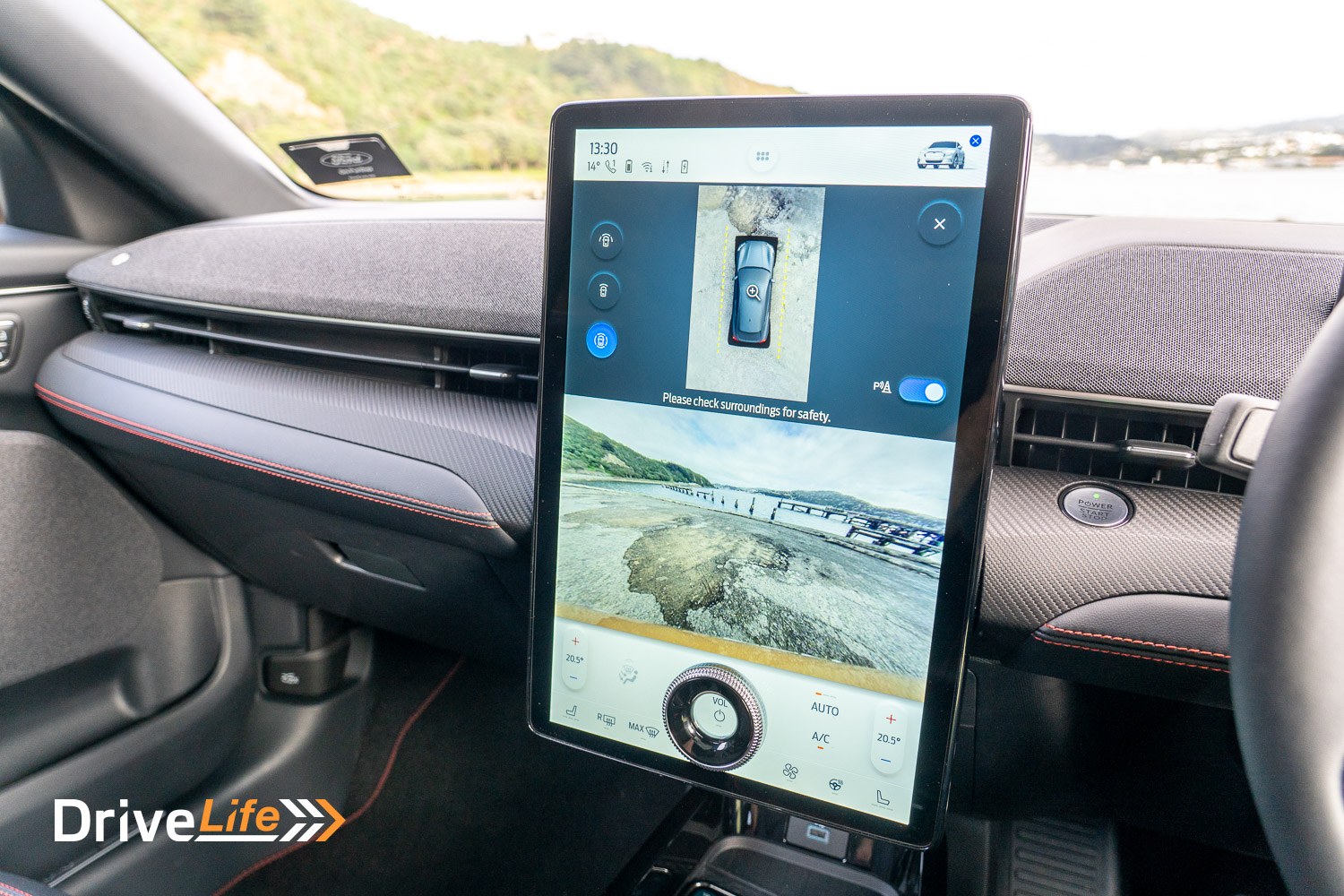
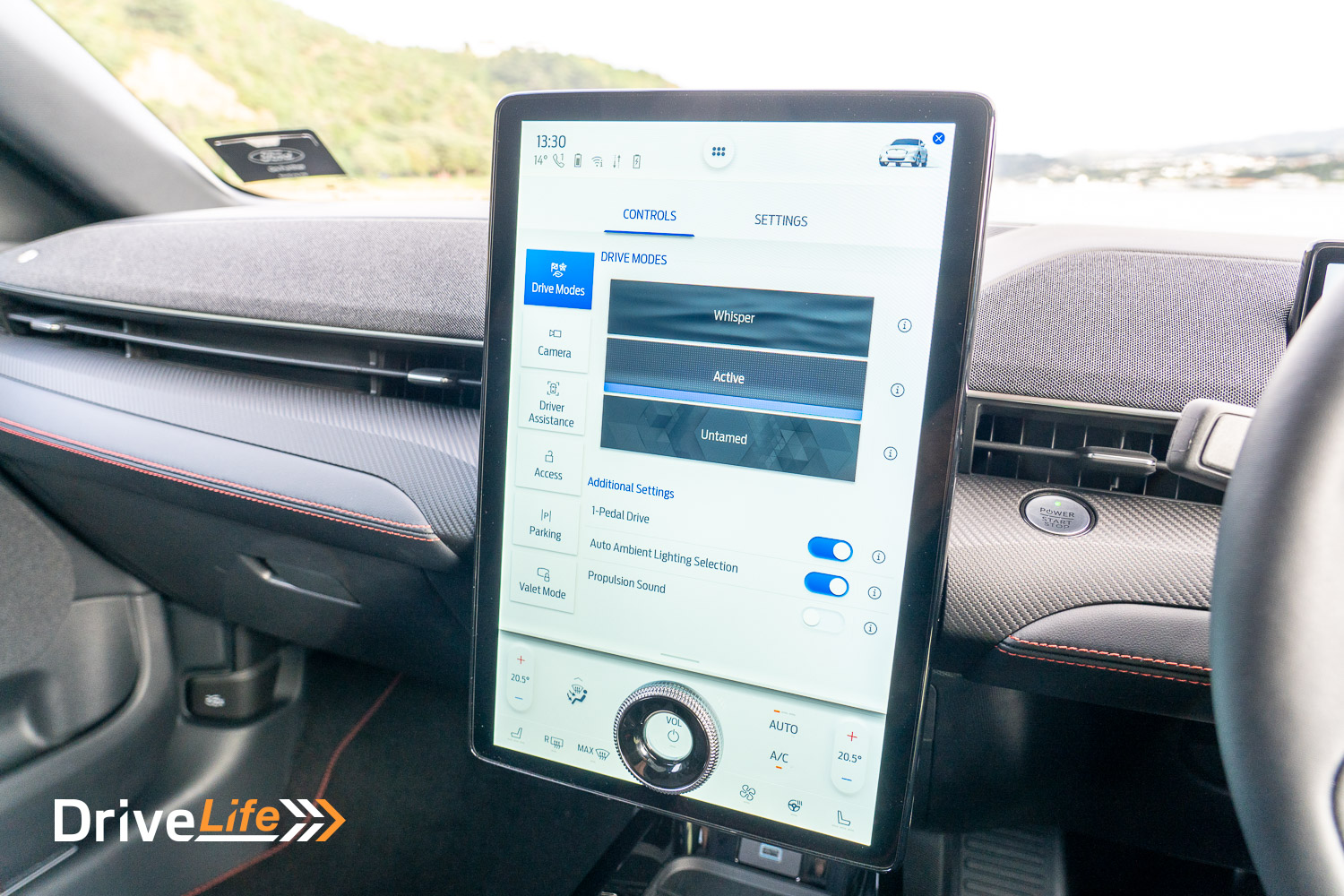
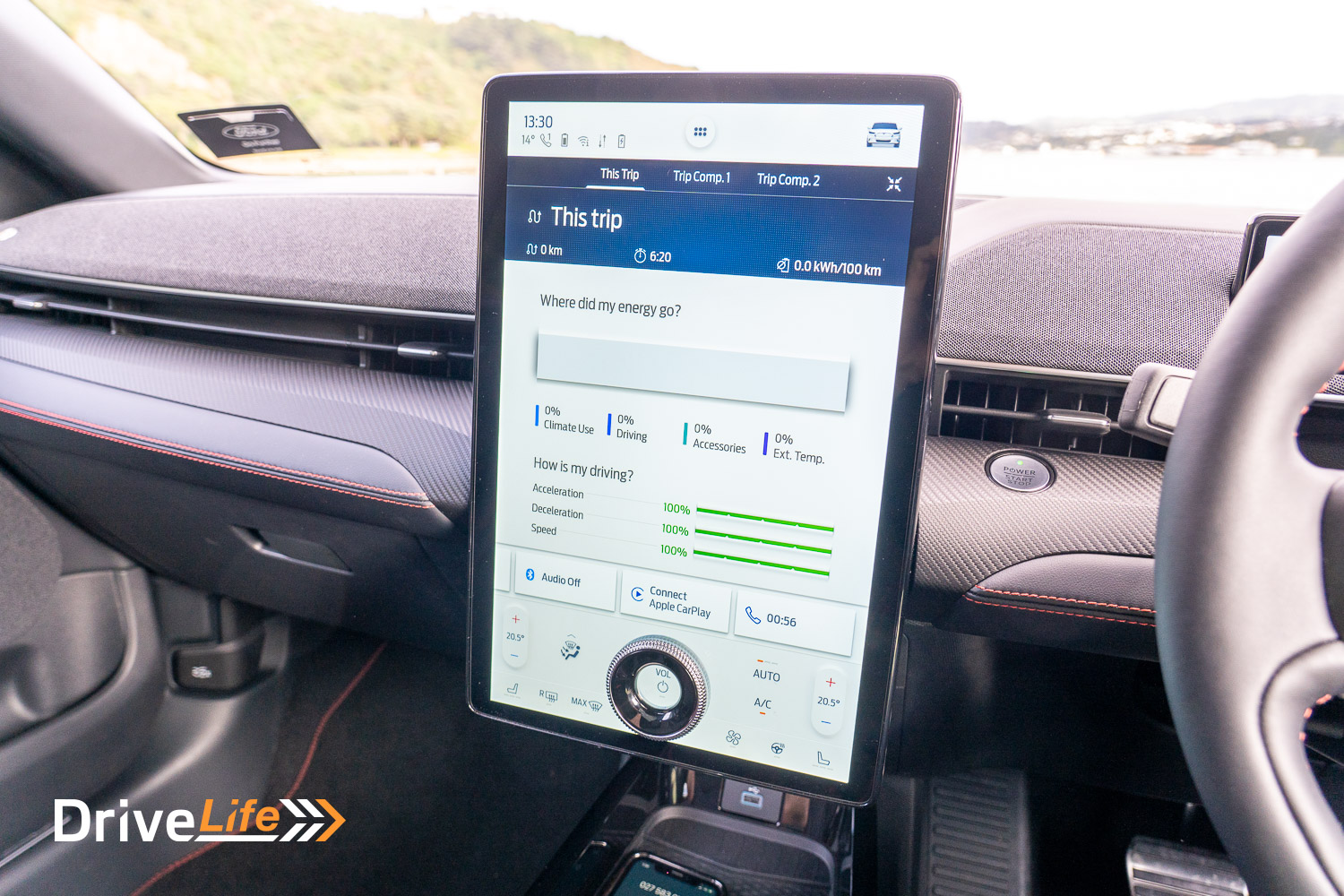
You do get some games, that can only be operated when the car is stopped. These include Blocks, Jigsaw, Lane Change, Sketch, Tiles, and Sudoku – something to keep you or the kids entertained while charging away from home. One feature of the centre screen that we don’t often see is the pop-up windows when you click on an ‘i’ (info) button next to any of the settings. The pop-up will tell you exactly what the feature you are about to change, does. It’s simple and excellent. Sometimes it’s a bit of a gamble to understand what a function does, if a manufacturer has given it some weird name.
Unlike the Tesla Model 3 or Model Y, the driver in the Mach-E gets a small dashboard that measures 10” across, but only say 3” high. It looks tiny and it looks almost unusable, but it’s perfect. The definition is outstanding, and while there isn’t much information shown on the display, everything you need is there. A nice touch are the words, ‘Ground Speed’ under the km/h display, a throwback to the word, ‘Mach’. There’s no customisation for the dashboard, other than having it light or dark, or leaving the setting on Auto. Our test car also had a MPH readout, but New Zealand-spec cars won’t have this.
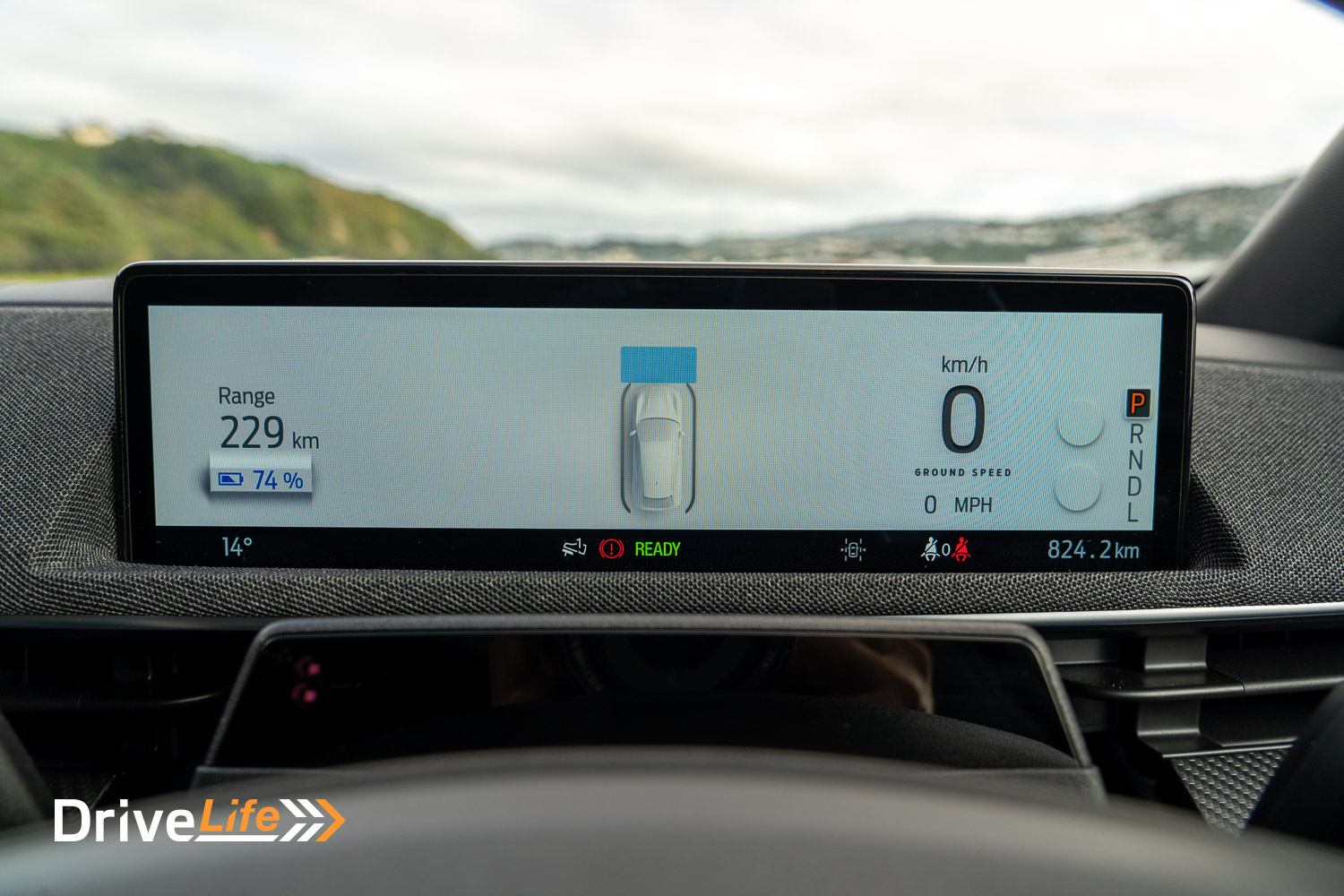
One surprising omission in the Mach-E is a heads-up display (HUD). At $110K, this should be standard, and even the GT model at $125K doesn’t have one. You do get a 360-degree camera, but it’s a two-button operation to get to it. I think this is one of the times where a steering wheel button or a separate physical button would have been better. On the plus side, if you get too close to an object, the 360-degree camera does turn on by itself.
I guess we need to talk about charging in the Mach-E. For a starter, the charging port is on the left-front guard. That means it’s a bit painful to use, compared to ports that are on the front or rear of the car. More than once, I had to edge the car forward to get the cable to reach when using a public charger. Secondly, the Mach-E does not come with a 230-volt, standard 10-amp trickle charger. Ford does not approve of using these, and so does not supply one with the car, or sell one. When asked, Ford suggested it’s because it would take around 40 hours to charge the car from flat to full on such a charger. But most EV drivers do not let their cars get that low very often. They will simply top it up each night at home, maybe taking 4-8 hours to get the car back up to full. You can of course simply buy your own trickle charger, if you wanted to.
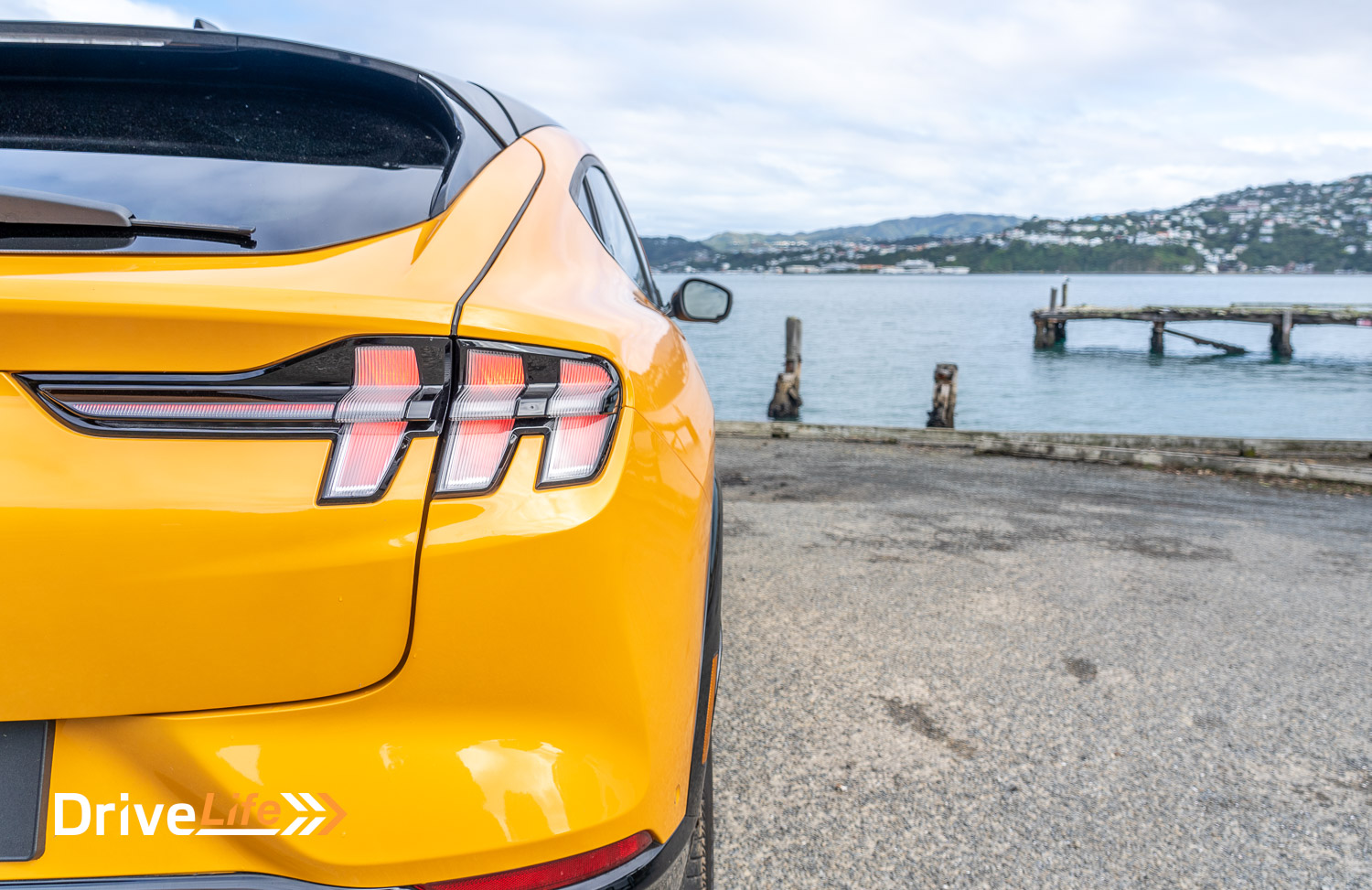
But there is the safety aspect around those chargers; they are supposed to be an ‘emergency only’ type of thing, where you use one to give yourself enough range to get you to a public fast charger. Ford strongly suggests that Mach-E owners should invest in a wall-type charger for home; it’s safer and you can get 4 times the amount of charge into the batteries compared to one of the trickle chargers. Fair enough. Since I don’t currently have a wall charger at home, that meant leaving the Mach-E at the local New World (with its 25kW charger) for around 2 hours to top the battery up. Time for me to invest in a wall charger, I think.
So, what about actually driving the Mach-E? Other than the brake regen we’ve discussed and performance in the different modes, it drives very well. Wind and road noise are extremely well subdued, and tyre noise is not too bad – even on coarse-chip seal. The AWD models are fitted with Bridgestone Turanza tyres, and these are definitely quieter than the far more common Michelin Primacy tyres that are fitted to EVs.
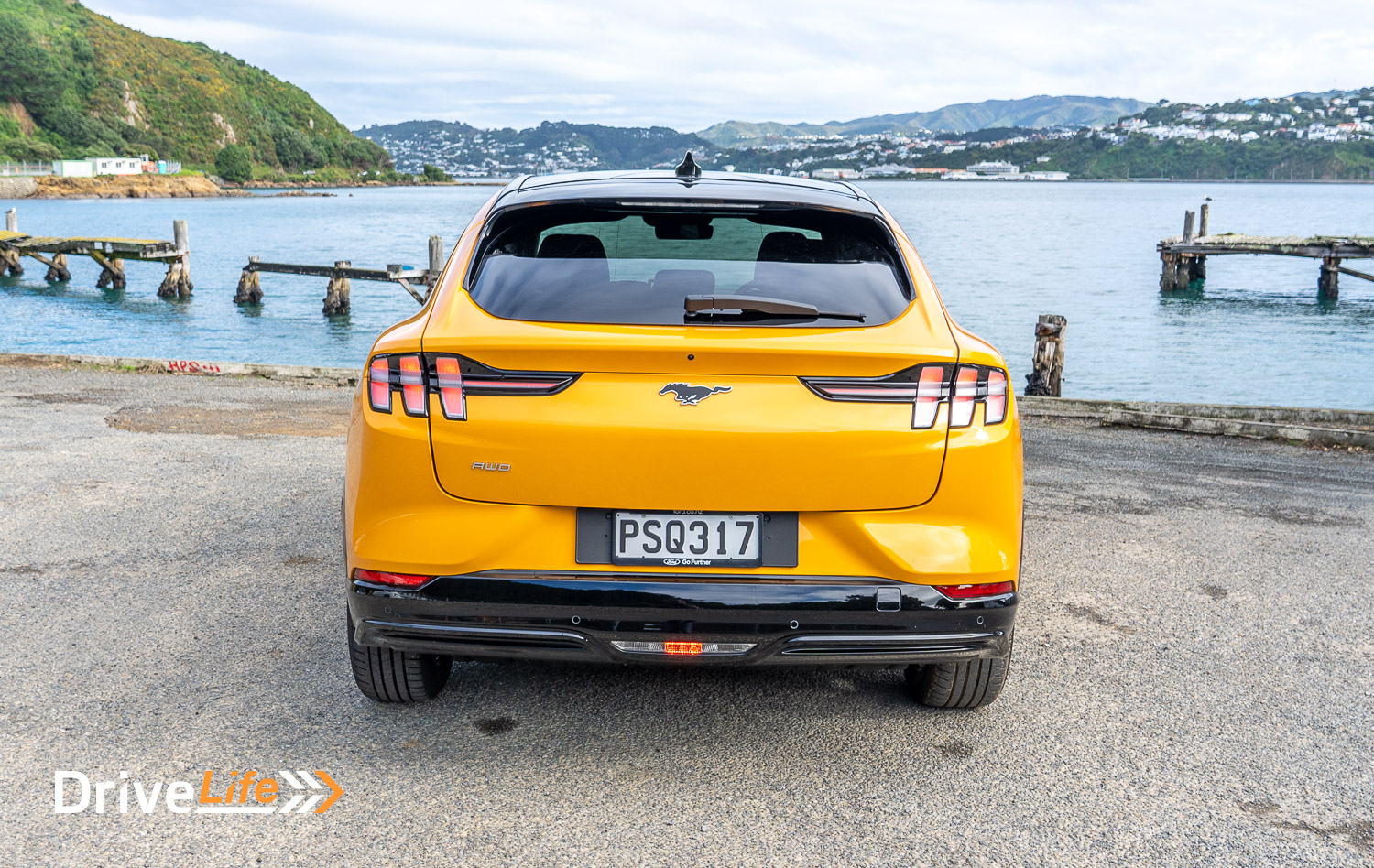
Ride quality is very good; usually, EVs as heavy as this ride very well due to their weight. Apparently, there’s been a change in suspension settings that all New Zealand models will get. We look forward to driving one of those to see if the ride improves.
Since our test car is AWD, grip is always excellent in all weather conditions. The available grip in rain is excellent, although you can always feel that 2-tons of weight lurking about, reminding the driver this is a heavy car. Doing a roundabout test shows the car is composed when pushing on, and again you can really feel the weight at all times – but it’s all very controllable and safe. On the open road, the car is a joy to drive; quiet, and comfortable, and it sits on the road well. I think over our almost 3,000km of testing, this was one of the biggest points noted.
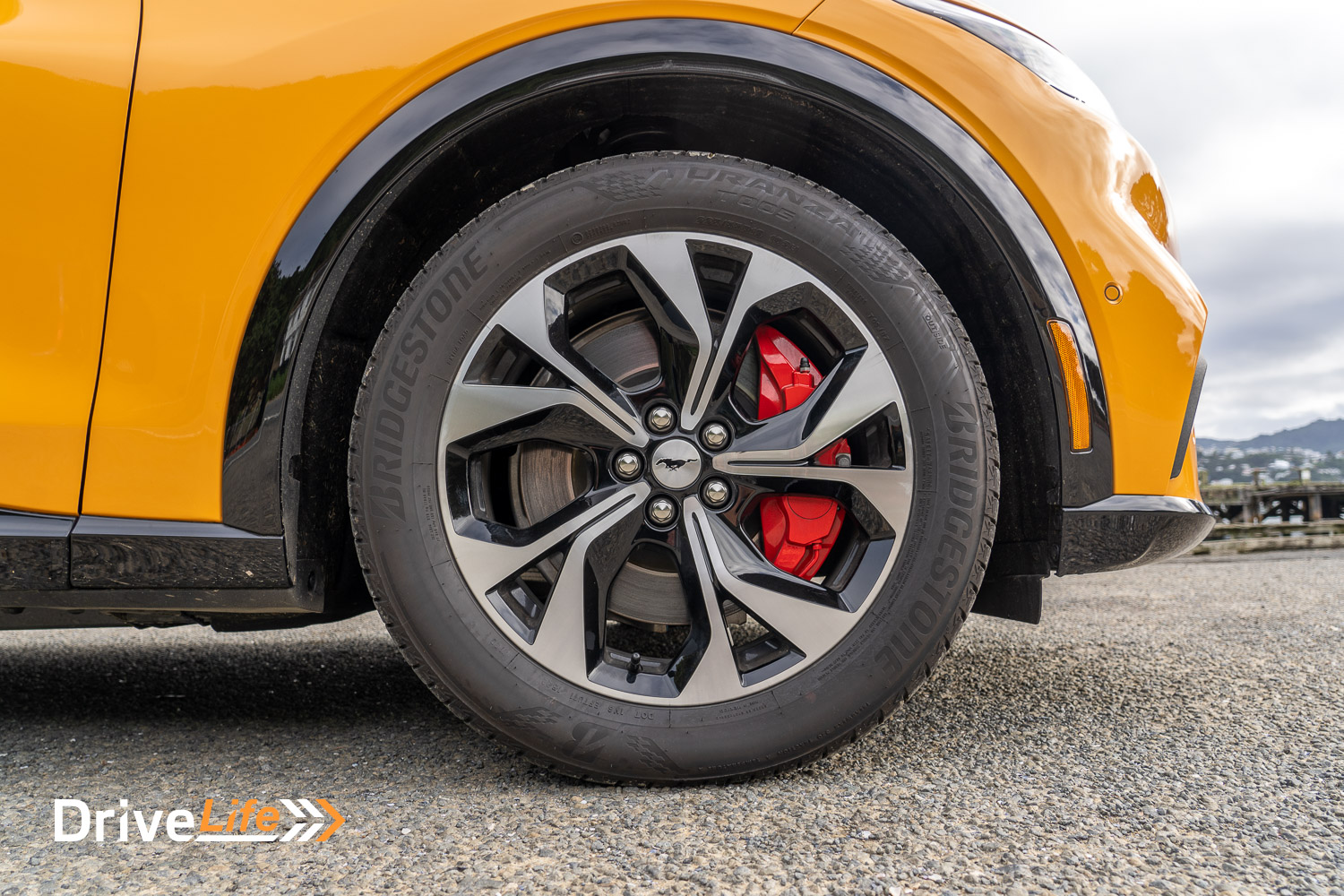
In city streets – especially Wellington’s – the width of the car wasn’t so much of a problem, as something I was constantly aware of. Looking in the rearview mirrors shows those haunches sticking out, and while they look cool, they’re a constant reminder of the width of the Mustang Mach-E. At 2.097m, it’s about 200mm wider than a Ranger.
The AWD model is fitted with adaptive LED headlights, and like other brands, they work well. The spread is deep and wide, and having the sides of hills lit up while you follow other drivers is excellent for safety. Actually, at night, it’s a little more special as you approach the Mach-E; a huge pony appears on the ground, projected from the mirror. Cool? Yeah, it is.
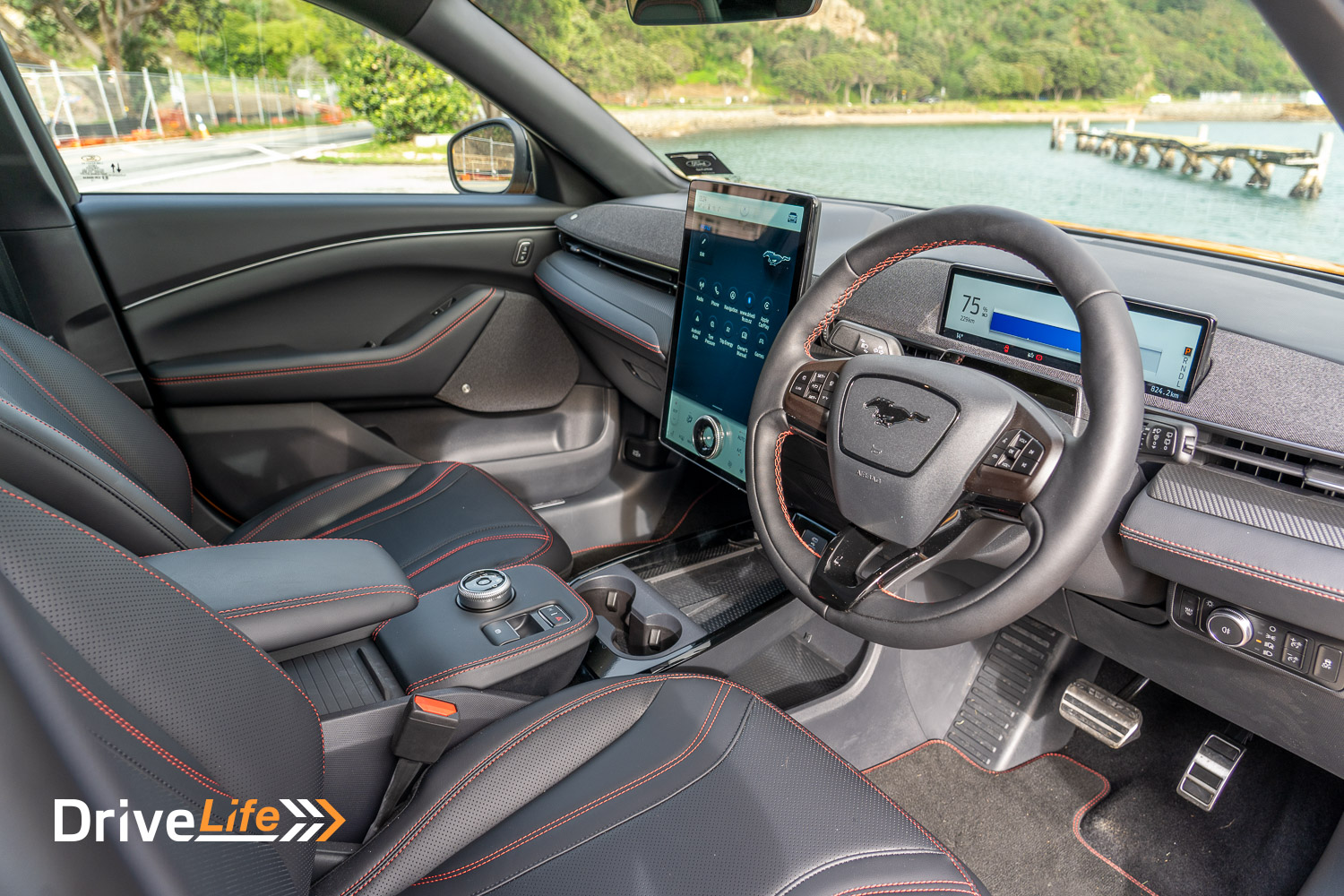
Like the Ranger and Everest, the Mach-E has intelligent adaptive cruise control. I know Alistair almost hated this feature and turned it off, but I love it so much. Having intelligent adaptive cruise means that if you are driving using cruise control and pass a speed limit sign, the cruise control will drop down (or speed up) to the new limit. It means the driver can really focus on what’s happening around the car instead of worrying about missing a change in speed limits (since we all know it’s only speed that’s an issue, right?).
This intelligence also runs to the speed limiter; You can turn the speed limiter on, and it will stop you driving over the speed limit (except downhill) and will change with any new speed limit signs it comes across. It’s a brilliant system and I desperately hope it filters down to other brands as well. Some other brands have a similar system but are still dependent on the drive pressing the ‘set’ or an ‘ok’ button to make the change happen. Ford’s system rocks – for me anyway.
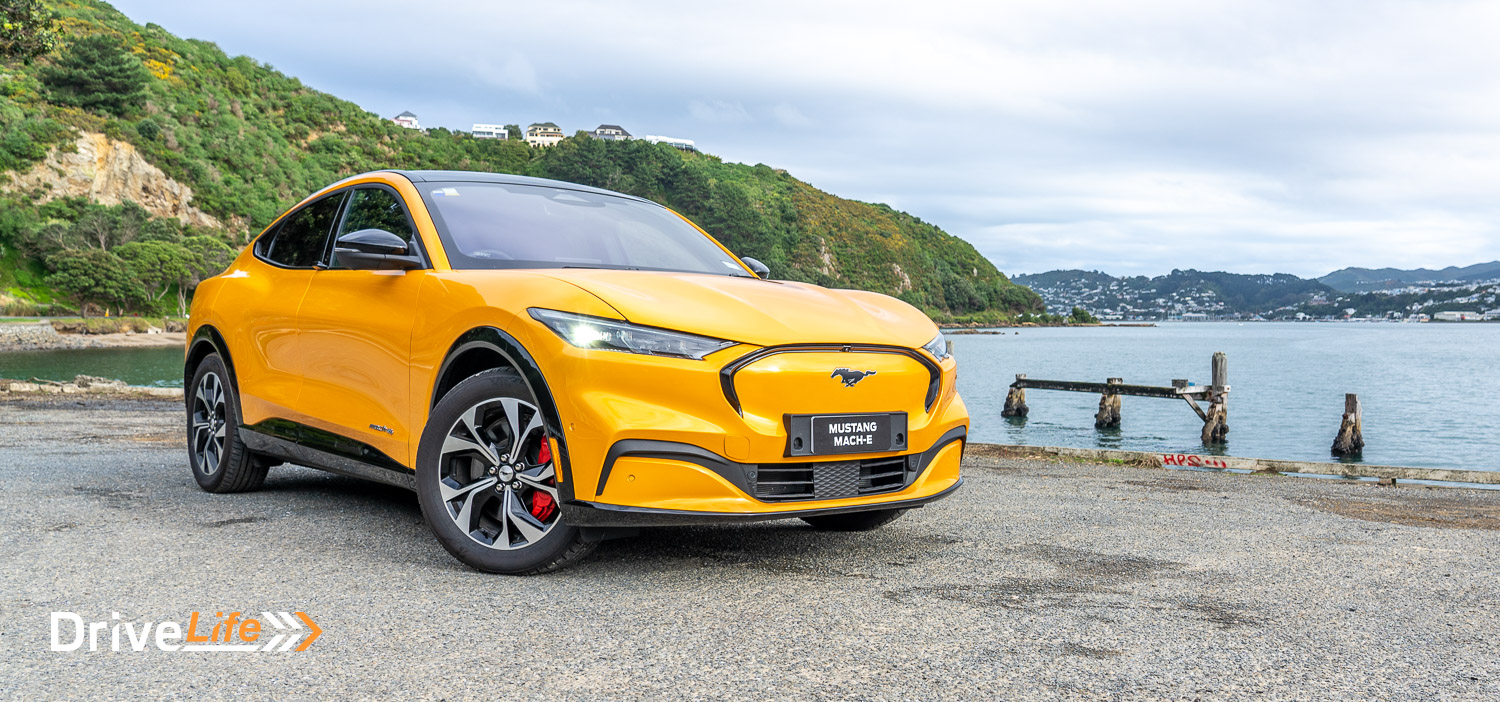
2023 Ford Mustang Mach-e AWD: Alistair’s Point Of View
A friend of mine has an 11-year-old son, who has an obsession with Mustangs. Although the Ford Mustang was arguably made famous before his time, the Mustang brand carries a legacy which, evidently, inspires younger enthusiasts. So, when I mentioned that I had a Ford Mustang on test, his face lit up. However, that enthusiasm was erased when he saw what “Mustang” that was. Not even the zany Yellow paint (or NYC Taxi yellow) could rouse his enthusiasm.
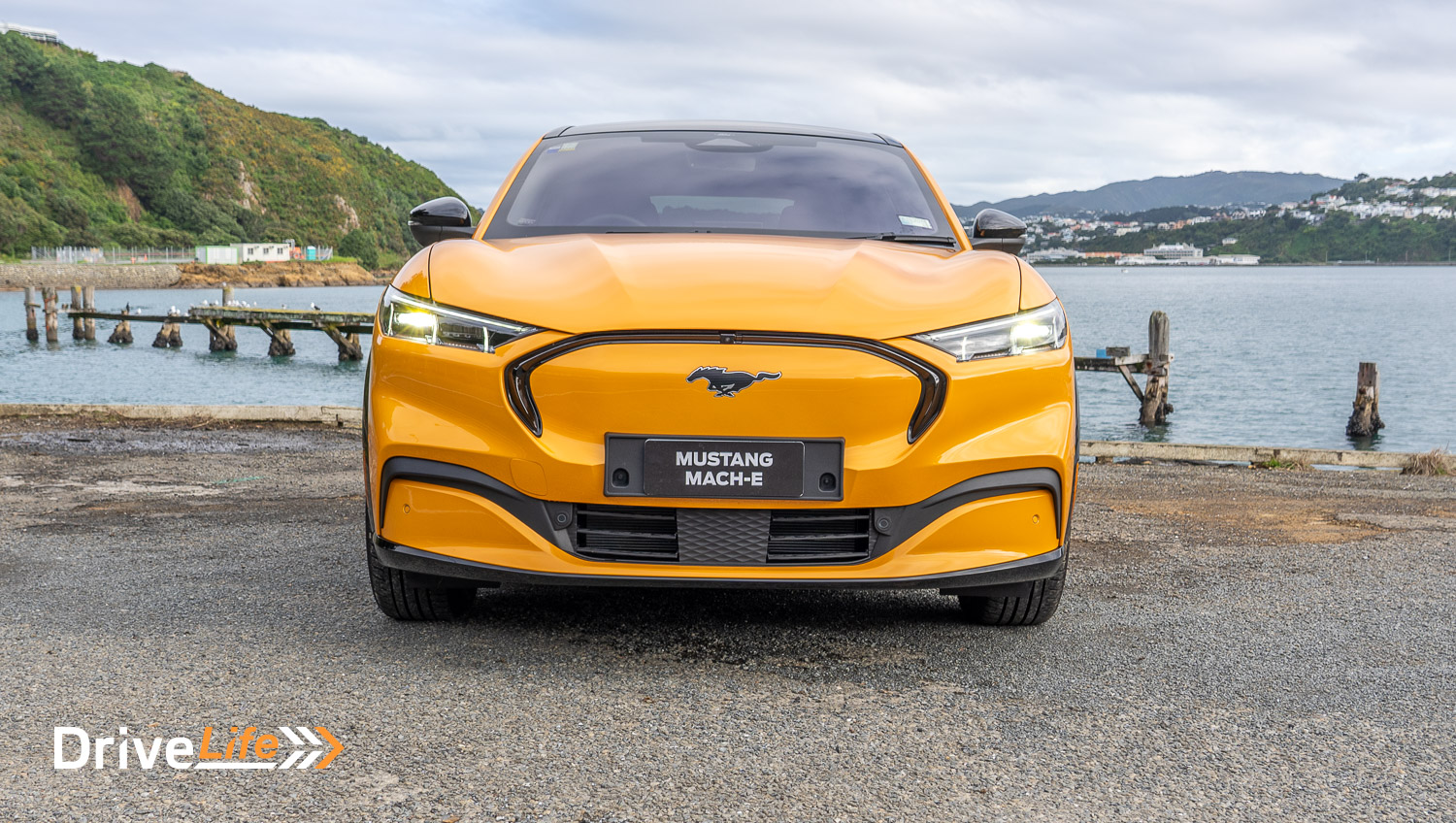
Was it mean of me to mislead this fantastical youngster? It certainly felt like it after some initial amusement had worn off. To me, the Mach-E is not a Mustang. I’m not an outlier with this opinion either. On the surface, it seems like Ford is a gutting of a heritage name, although, I suspect I know why.
Attention is everything in a 21st-century media world and controversial topics dominate. Taking the Mustang name and applying it to an electric crossover was almost certain to grab attention. I’ll admit, the clickbait worked. It drew attention to Ford’s first-ever, dedicated EV crossover, which can have quite easily slipped under the radar if named anything else. Perhaps this was a brilliant move after all? So, now that you’ve taken the bait, is there actually any content to the Mustang Mach-E?
Well, yes. If you’re after a competent electrified SUV, that is. The Mach-E is comfortable, quiet, and all things considered, a well-rounded SUV. It rides beautifully, the front seats are excellent, and the build quality is good too. The electric motors have a rearward bias, meaning the Mach-E does rotate in corners rather well for what it is, but the Mach-E is a heavy crossover (nearing 2.2 tonnes). Also, the comfort-biased dampening doesn’t bode well for the Mach-E body control on a twisty road. A sports car, the Mach-E is not.
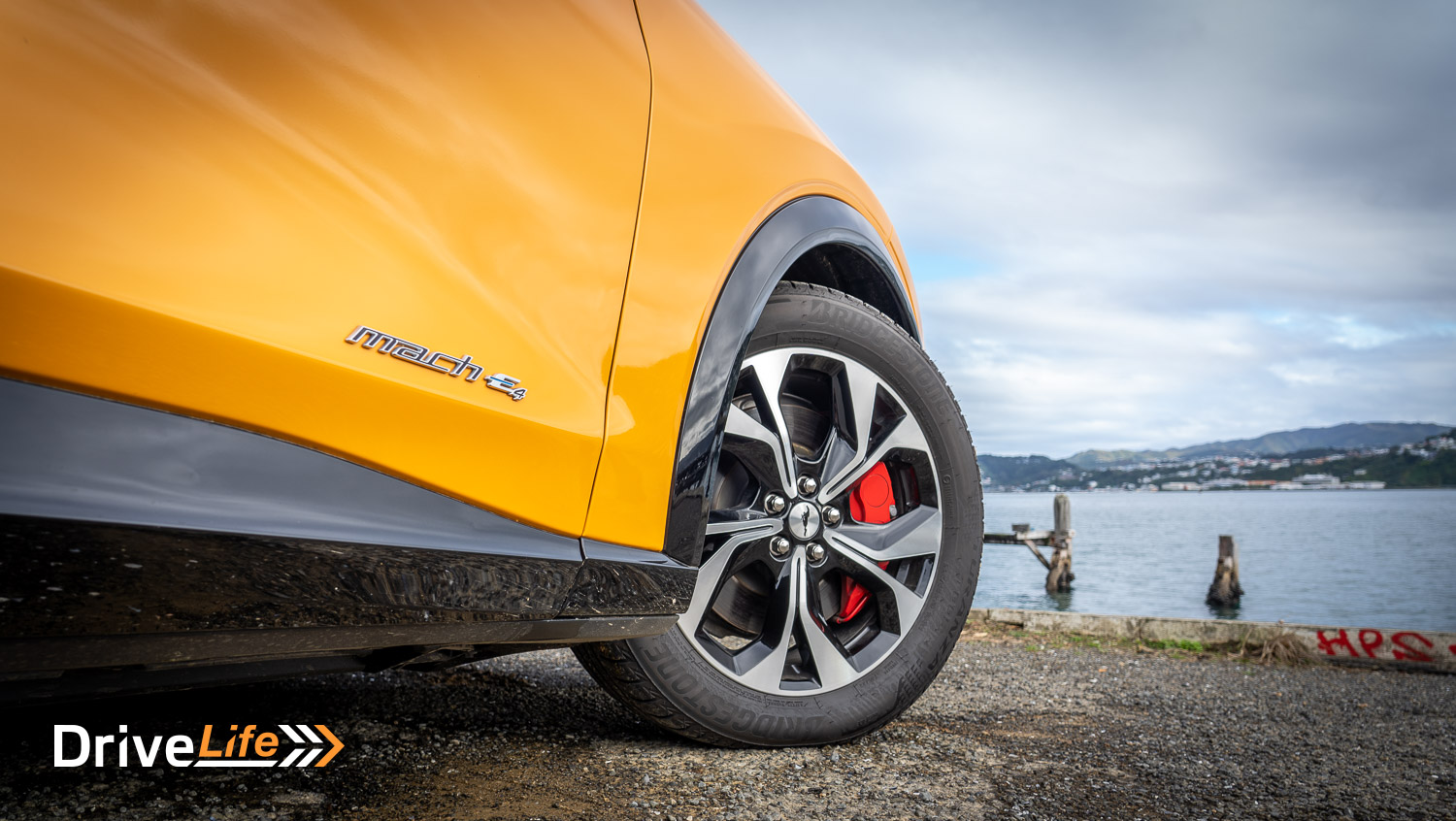
Even though it’s a competent daily, the Mach-E isn’t perfectly polished. The brakes are far too grabby, and I never really got used to them. Secondly, there’s no adaptive regen braking – it’s either coast or one-pedal.
I also found the infotainment to be a mixed situation. The screen resolution and UI are generally good, but the climate controls are awful to use while driving. You can use the volume knob for adjusting the heated seat controls in NZ-new cars (our Irish test car couldn’t), but this seems like something they had to think of, after realising there was a problem. Speaking of that volume knob, who honestly thought it was a good idea to mount it on the screen? Sure, it’s different, but it also creates a dead space of unusable screen. It’s weird.
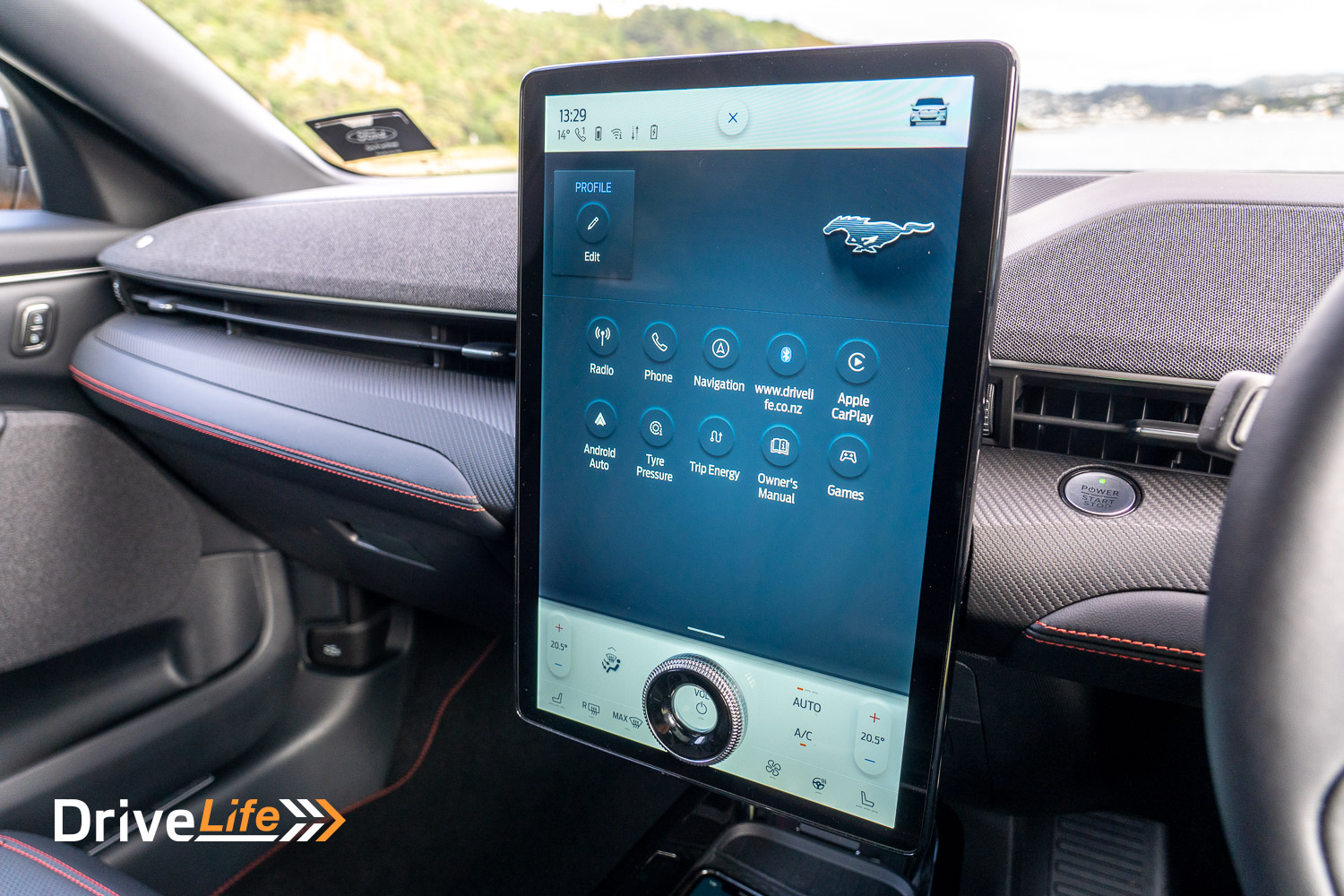
But, the worst tech offender is the automatically-adjusting speed limit when using the adaptive cruise control. Basically, it uses traffic sign recognition to set the speed of your cruise control. I was caught off-guard when I first encountered this software. So too, was the gentleman who ended up tailgating me when the car decided to slow from 100kph to 60kph on the motorway. I wasn’t pleased, and neither was he, judging by his one-fingered salute. Following this event, that feature was switched off. Permanently.
On the whole, I suppose that my experience of the Mach-E was more mixed than Fred’s experience. He seems to love this big heavy Taxi-colour pony. But, we can both agree that the Mach-E doesn’t really fit with the ‘Mustang’ family. It makes you wonder why Ford couldn’t have used another name. Like Thunderbird, perhaps? At least “Thunder” would be somewhat relevant.
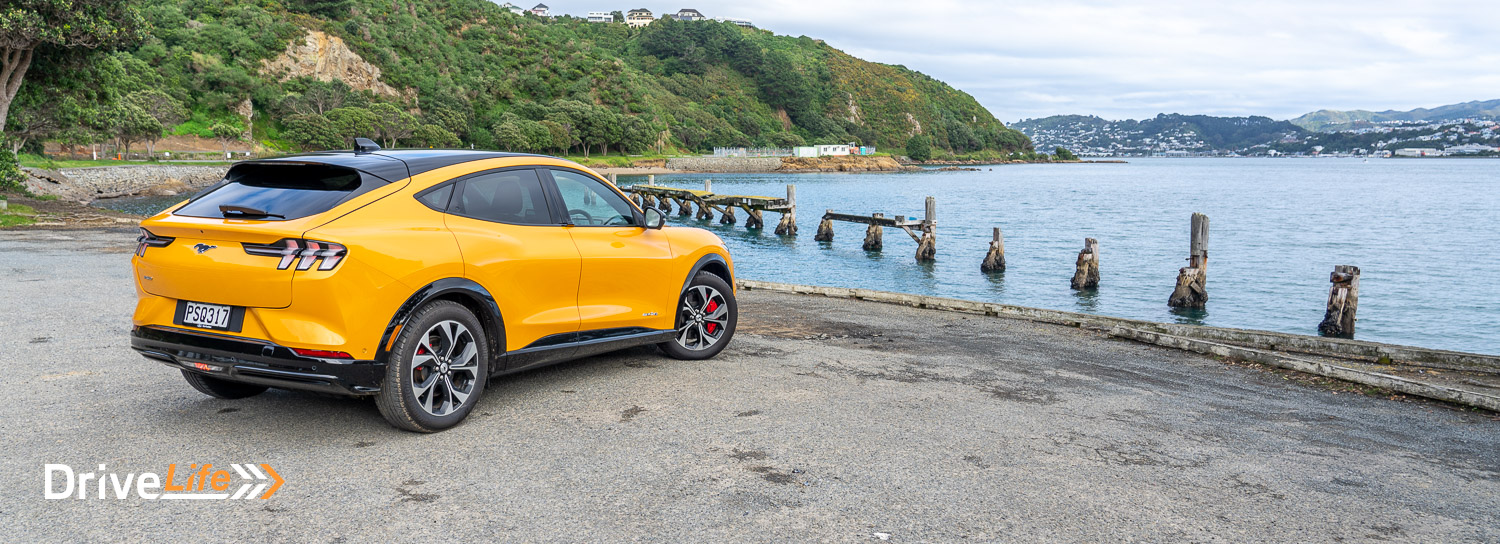
2023 Ford Mustang Mach-E AWD: Tirau Trip
After handing off the car to Alistair to test out, I grabbed it back for a weekend away in Tirau, but staying on Lake Taupo overnight. After the horrendous weather during my 600km drive from Auckland in the Mach-E, I was very happy to find perfect weather for my drive up to Lake Taupo.
I wasn’t expecting too many revelations on this drive, since we had already covered over 2,000km in the Mach-E. An issue did reveal itself, but nothing to do with the Mach-E. I left Wellington with a battery sitting on 95% full, and a real-world range of around 300km (bear in mind that the New Zealand-spec models of the AWD Mach-E will have a battery that gets around 100km extra range). Anyway, there I was heading North, and thought I’d pop into Levin and top the car up, to enable a straight drive through to Turangi for a top-up. But the Levin Chargenet charger was busy. Not wanting to be bothered going to the BP (don’t ask why), I cruised North and stopped at Bulls, where there are two chargers. Both busy. I kept going and pulled in at Mangaweka – charger busy and the guy had just plugged in. No problem, I kept going to Taihape and shot around to the charger – again busy. A guy with an Ioniq 5 had just plugged in and said he just waited 45 minutes for it to come free.
Not wanting to wait longer, I checked my range; 29km left. Distance to Waiouru? The same 29km as my range. Since my wife wasn’t with me, I decided to give it a shot, and drove carefully and as economically as I could to Waiouru, but still maintaining 100km/h where it was flat. The distance to empty and distance to Waiouru both went down in tandem, but I did make it to the Army Museum with 4km and 1% battery remaining – and both chargers were available. Phew!
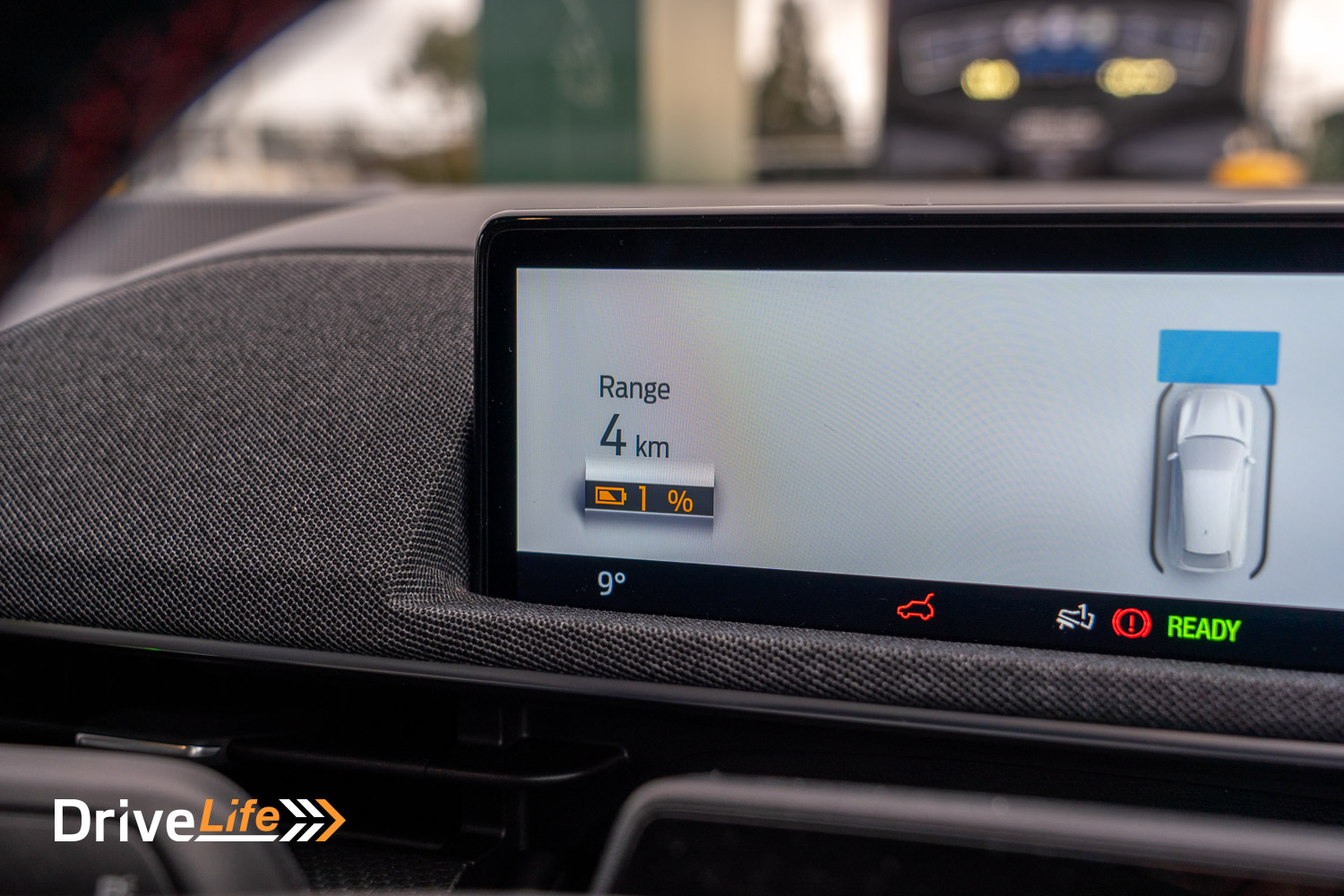
I believe this goes to show that we need more EV chargers for people on the move. It took me 90 minutes to get the Mach-E back to 80% charge, but I would have rather done smaller charges more often. With more and more EVs being sold, this can only become a bigger issue. Still, at least I made it.
After my weekend away, it was time to head home. I got to the Taupo hypercharger with 7% charge left and plugged in. In 30 minutes, the state of charge was at 80%. I love hyperchargers. The Mach-E is supposed to take up to a 150kW charge, but at 16% of charge, this had already dropped to 90kW, and slowly reduced from there the higher the state of charge went. Still, 30 minutes to get to 80% for this size battery is acceptable.
That charge got me to Bulls where I plugged in again to the hypercharger there, had some lunch and before I finished eating, the car had charged up.
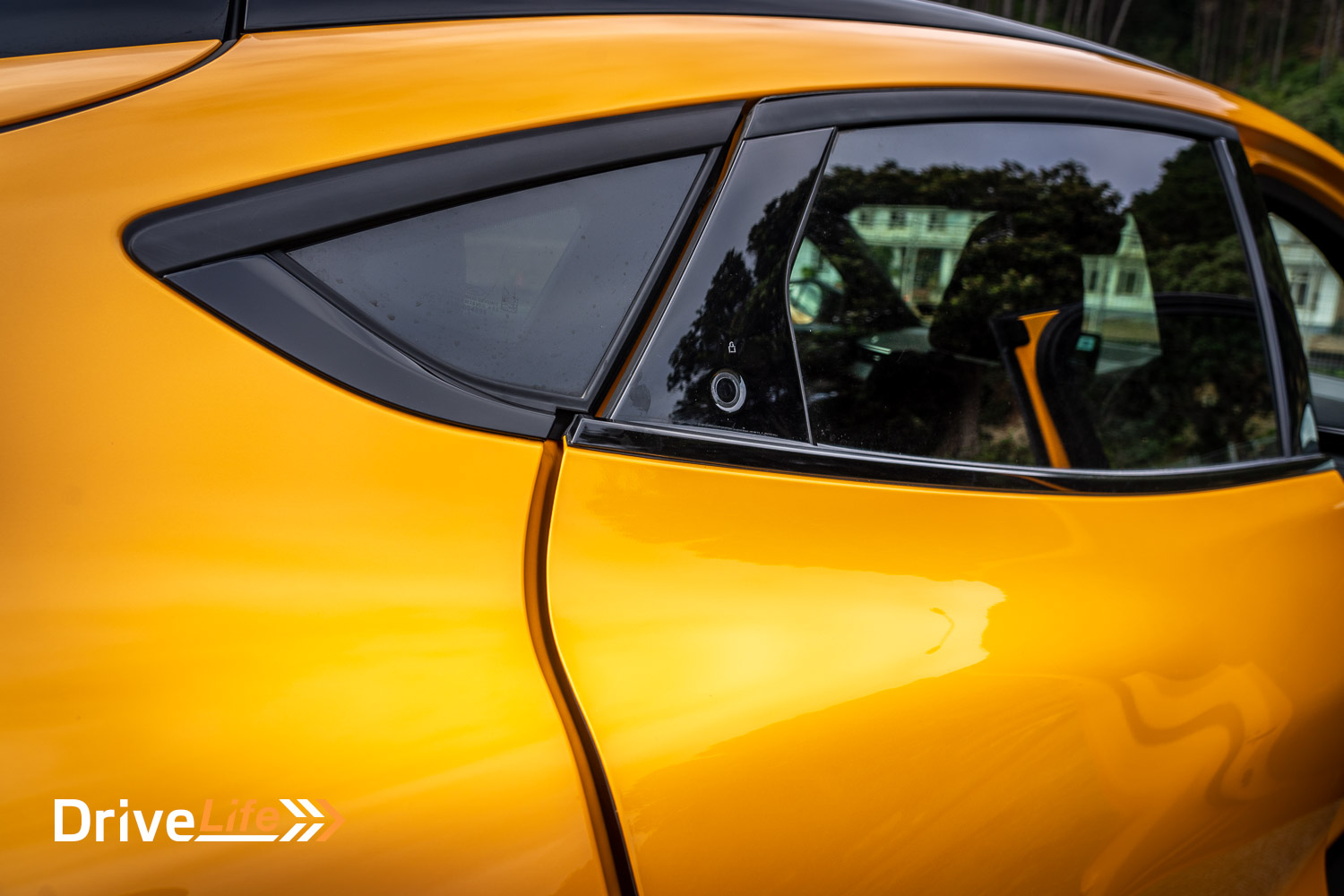
So what about the energy economy for the 2023 Mustang Mach-E? We covered just under 3,000km of mixed driving, in mostly wet weather. As mentioned, rain (and/or a headwind) is always going to affect your EV range and economy. Ford states that the AWD model should use 20.7kWh/100km, and we got a result of 21kWh/100km. For the weight of the car, the long-distance driving we did, and the weather we had that’s a good result.
If you compare the Mach-E to other EVs of similar size, it’s pretty much as expected. The real-world figure we got from the Polestar 2 was 21.9, the EV6 18.5, and the Ioniq 5 Limited 17.0. While we haven’t reviewed the Performance model of the Tesla Model Y yet, we got 16.4 from the rear-wheel drive version.
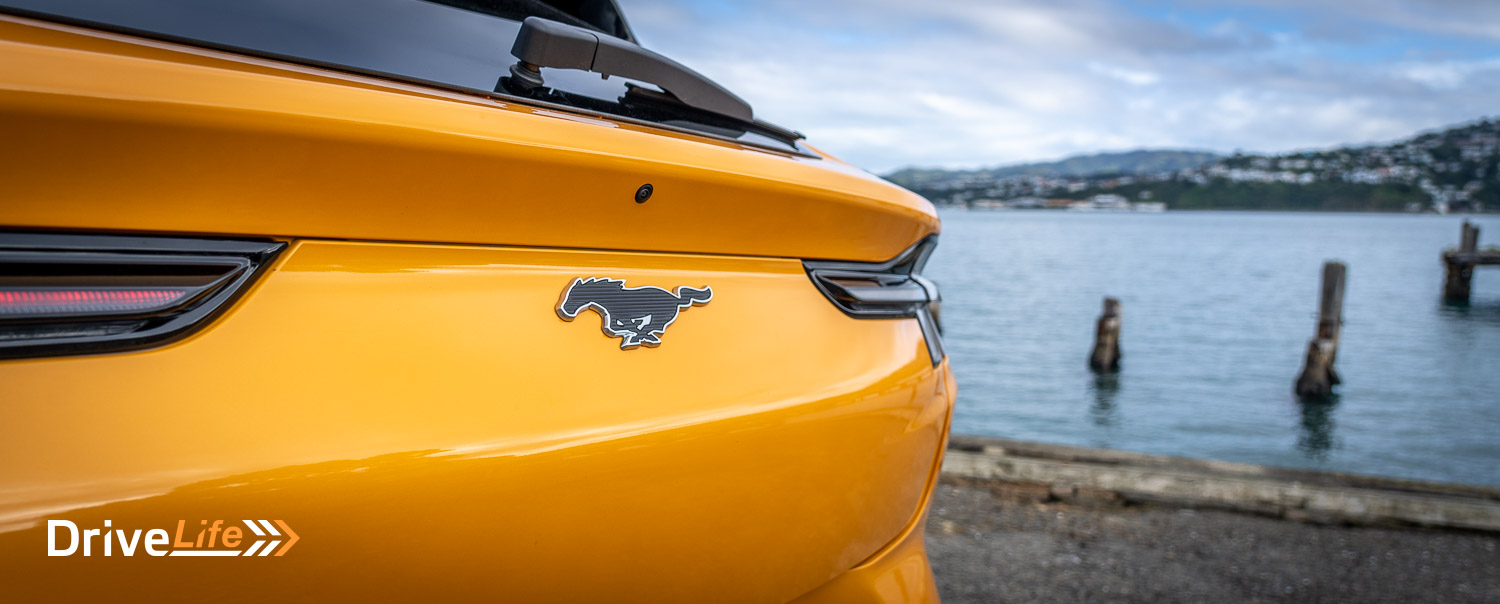
2023 Ford Mustang Mach-E AWD – Specifications
| Vehicle Type | Medium all-wheel drive EV SUV |
| Starting Price | $109,990 |
| Price as Tested | $109,990 |
| Engine | Dual electric |
| Power, Torque kW/Nm | 258/580 |
| Transmission | 1 speed |
| Spare Wheel | Pump only |
| Kerb Weight, Kg | 2,182 |
| Length x Width x Height mm | 4713x2097x1624 |
| Boot Space / Cargo Capacity, Litres (seats up/seats down) | 519/1,420 Frunk: 100 |
| Energy Economy, kWh/100km | Advertised Spec – Combined – 20.7 Real-World Test – Combined – 21.0 Low Usage: 6-10 / Medium Usage 11-19 / High Usage 19+ |
| Towing Capacity Kg, unbraked/braked | Not rated |
| Turning circle metres | 11.6 Small: 6-10m / Medium 10-12m / Large 12m+ |
| Warranty | 5 Years unlimited km 8 Years/160,000km battery warranty |
| Safety information | ANCAP Rating – 5 stars – Link Rightcar.govt.nz – 5 Stars – PSQ317 |
Have you enjoyed this review? Be sure to join our monthly email newsletter list so you don’t miss a single car review!


